The Summer Classic Auction is LIVE!
The world's best auction house presents our newest auction featuring an exclusive collection of more than 50 amazing graded cards and autographed tickets, as well as other rare sports collectibles, for your consideration and bids.
Overview of Top Auction Items

Football
Lot # 1123: 10/1/60 Ernie Davis Photo-Matched Syracuse University Game Worn Jersey vs. Kansas (Resolution Photomatching LOA)Syracuse road football jersey worn by legendary running back Ernie Davis in a game against Kansas held at Memorial Stadium in Kansas on October 1, 1960 and conclusively photo-matched by Resolution Photomatching with their ResMatch LOA. This is perhaps the most highly documented Ernie Davis game-worn jersey in the hobby. Resolution was also able to identify Ernie wearing this jersey on his 2015 Flawless Diamond /20 and 2015 National Treasures College Materials cards. Not only has it been conclusively photo-matched to that contest, but it is also accompanied by a one-page notarized LOA from our consignor detailing how he personally obtained it on that day, together with his program from the game.
The white "tear-away" jersey features the number "44" on the front and reverse in navy tackle twill with orange stitching. A "Wilson 46" label is located at the base of the crotch strap. As one might expect, the jersey displays considerable wear, with numerous large tears throughout (the very thin material of these "tear-away" jerseys was conducive to tears, hence their name, and as a result, they were usually single-use garments). A large circular tear on the right shoulder/upper sleeve is especially significant because it can be prominently seen in a photo of Davis carrying the ball during the October 1, 1960, game against Kansas. (The photo-match for this item can be accessed at Getty Images under Editorial #515258866.)
Our consignor, who was fifteen years old at the time, attended the October 1, 1960, Kansas football game against Syracuse. His father was a KU alumnus and the pair had regularly attended Kansas football games for the past nine years. In his accompanying letter, he describes how he obtained the jersey. In part:
As was our habit, Dad and I would leave the stands with two minutes to go in the game.... On this day, the Orangemen were leading with two minutes left. As we walked behind the Syracuse bench, we noticed a pile of jerseys. Dad said to me, "Why don't you ask someone if you could have one of those jerseys?" Too shy to do that, I just grabbed one off the top of the pile and stuffed it inside my jacket. To this day, I don't know why my Dad didn't make me ask or put it back. (Those were the ethics he taught.) Outside Memorial Stadium and what seemed like blocks away, I naively (without any expectations) pulled out the jersey. Of the seven or so jerseys discarded that day, I had a prized possession - the jersey of the already famous Ernie Davis!
The story of Ernie Davis is one of the most tragic in sports history. Davis enjoyed a stellar collegiate football career at Syracuse, where he followed in the footsteps of his idol, Jim Brown (he wore #44 because that was Brown's number at Syracuse). Following his 1961 senior season, Davis became the first African American to win the Heisman Trophy and was selected by the Washington Redskins with the number one pick in the NFL draft. Because of their racist policies at the time, Davis refused to play for the Redskins and was traded to the Cleveland Browns, where he would team in the backfield with Jim Brown. Unfortunately, Davis never played a down for the Browns after being diagnosed with Leukemia. Davis died two years later at the age of twenty-three. In honor of his memory, the Browns retired Davis' issued uniform number ("45"). Davis was inducted into the College Football Hall of Fame in 1979.

Basketball
Lot # 5: 1/12/11 Stephen Curry Golden State Warriors Signed Game Used Sneakers - First Double-Double vs. Kobe Bryant (Resolution Photomatching LOA & PSA)Outstanding rare pair of game used sneakers from Stephen Curry's sophomore season in the NBA, specifically to January 12th when Curry registered his first career double-double against Kobe Bryant. Conclusively photo-matched by Resolution Photomatching, the sneakers have yellow ankle cuff with blue swooshes and Nike lettering, and no size tagging apparent with each bearing an "SC 30" logo on the tongue and the year "2010" on the lace loops. Moderate use is displayed including some minor scuffs and cracking to the swoosh on the outside of the left shoe. Shoes also show great use that suggests use in multiple games and were obtained through a college friend who went to Davidson with Curry. It is very important to note that these are from just his 2nd NBA season, before he signed his deal with Under Armour in 2013, thus it is quite rare to find a pair of Nike game used Curry sneakers. Now 14 years into his sensational career, Steph's phenomenal 3-point shooting prowess still makes him one of the most feared players in the game as he looks to build on his four NBA Championships to go with two MVP honors and leading the league in scoring twice, all while serving as the face of the Golden State Warriors. Comes with PSA LOA for the signature.
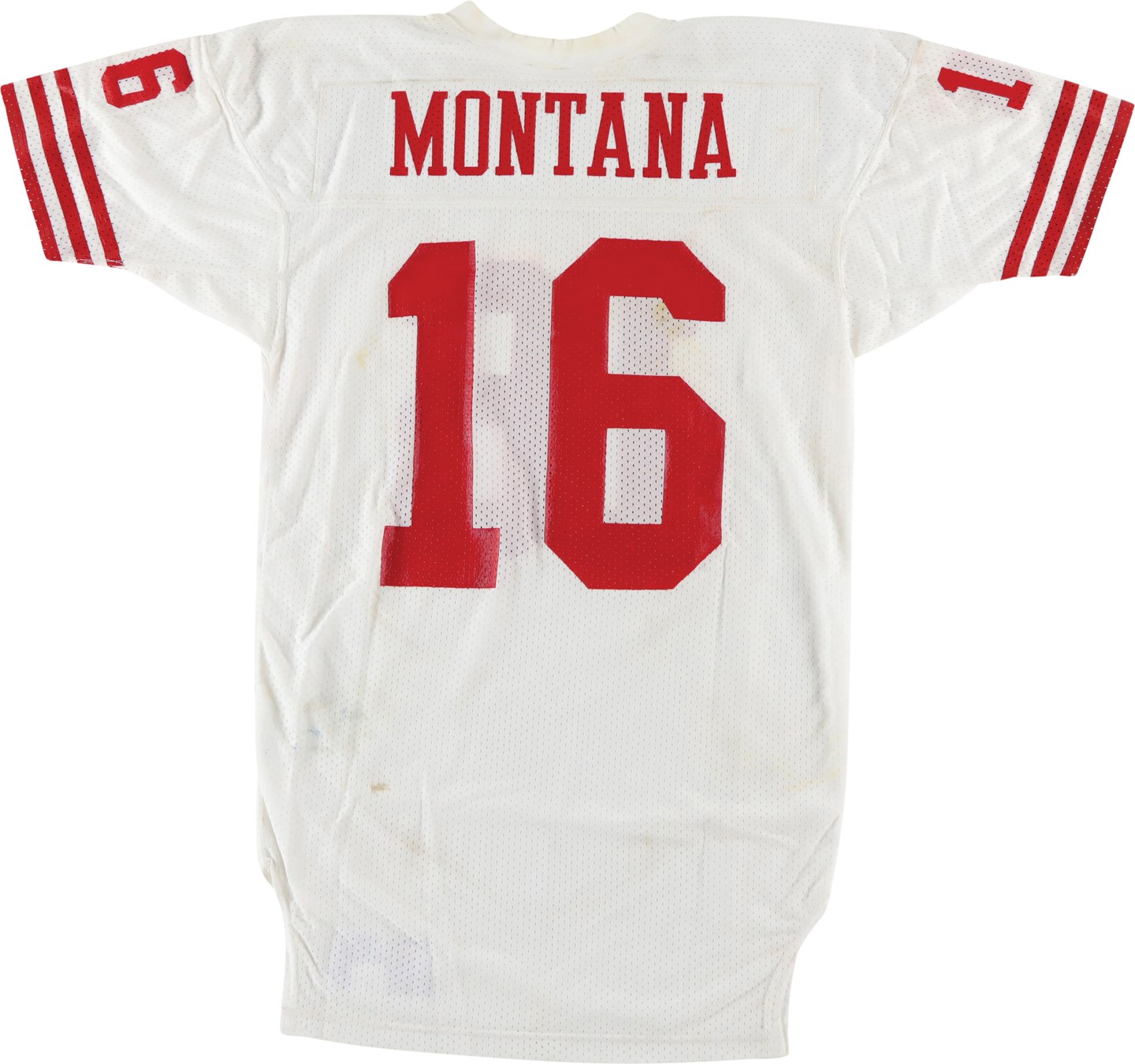
Football
Lot # 3: Historic 12/11/89 Joe Montana Record-Breaking San Francisco 49ers vs. Rams MNF Signed Game Worn Jersey - Montana Throws TWO 90+ Touchdowns & Second Highest Passing Yards Game of His Career (Sports Investors Photo-Matched LOA & Family Sourced)Photo-Match: The jersey has been conclusively photo-matched by Sports Investors and comes with their LOA. Please see recently uploaded photos of the photo-match and LOA.
An elite offering from an elite competitor, this signed 1989 Joe Montana San Francisco 49ers jersey was game worn by the gun-slinging Hall of Famer in his record-breaking Monday Night Football performance against the Los Angeles Rams on December 11th, 1989. The following list of accomplishments, along with family sourced provenance, is why this jersey is one of the finest known Montana examples in existence: 1) Montana becomes the only QB to throw TWO 90+ yard touchdown passes in a single game. 2) 286 passing yards to John Taylor broke 49ers record for receiving yards in a game. 3) TWO 90+ passing TDs to John Taylor - the first and only time a player scored two 90+ TDs from scrimmage in one game. 4) 49ers clinch the division title. 5) Last regular season game of Montana's final Super Bowl Championship season. 6) Montana's first career 450+ passing yard game (career high at the time). White mesh jersey has Russell Athletic size 44 and 100% nylon tagging on tail, number 16 is on front, sleeves, and back; name is above back number, all screened in red. Signed on the front number "1" in black fine-tip Sharpie and dated "12/11/89." Nice use displayed includes sweat stains to the front of the collar, though it generally retains a bright look, a testament to his offensive line and a quick release. Considered by many to be the GOAT before Tom Brady arrived and removed all doubt, Montana worked his typical magic in the December 11th contest against the Los Angeles Rams in which this gem was used. Joe Cool lived up to his nickname, throwing for 458 yards (his 2nd highest single-game total) and three touchdowns, overcoming a 17-point deficit while spurring a 20-point 4th quarter rally in a 30-27 victory over the Rams. By way of provenance, our consignor was the original owner of this jersey who got it at auction days after Joe wore it against the Rams and it was presented to him by Theresa Montana (Joe's mother); the auction in which this jersey was sold was a part of a fundraiser for the Burlingame High School athletic department. Not only did Montana lead Notre Dame's Fighting Irish to a National Championship and a thrilling finale to the 1977 season, he then proceeded to win four Super Bowls without a loss, being named as the game's MVP in three of them. Comes with PSA LOA for signature.

Baseball Equipment
Lot # 717: 2001 Barry Bonds HR #25 Photo-Matched Game Used Bat from Historic 73 Home Run Season (PSA GU 9.5 & Resolution Photo-Matched)Barry Bonds' historic 73-home run season featured many milestones along the way, including his becoming the fastest man to hit 25 in a season when he victimized Rockies right-hander John Thomson in San Francisco. The shot - which was career homer #519 for Bonds - came in just his 44th game of the campaign and is inscribed on the barrel: "5-24-01 #519." The Original Maple Bat Co. Bonds 2K1 model bat is 34" long and weighs 32.9 ounces. Exhibits excellent use with a slight handle crack, several ball marks and ball stitch impressions (including blue and red ink transfers) on all sides of the barrel. Cleat marks can be seen on the back barrel. A light coat of pine tar is visible on the upper handle, which has been taped approximately .25" with 3" of tape removed with residue on the handle. The weight, length, model number, date of manufacture, and B.B. initials are written in black pen on the top of the barrel, while the home run reference" "5-24-01 #51" is written in silver on the left barrel. PSA GU 9.5 LOA and Resolution Photo-matched LOA with Bonds hologram on the barrel.

Baseball Equipment
Lot # 723: 2019 Mike Trout "MVP" Signed Game Used Bat (Photo-Matched, PSA GU 10 & Anderson Authentics LOA)Used during the preseason for sure and quite possibly during the regular season, this Mike Trout Old Hickory bat weighs 32.7 ounces, has been photo-matched to a Spring Training game and comes with Resolution Photo-Matching PSA paperwork. The maple, black-finish MT27* model features a cupped end, is uncracked and shows evidence of excellent use. Several ball marks and ball stitch impressions are visible on the left, front and back barrel, including blue ink transfers. Additionally, there are cleat marks on the back barrel, impressions of a weighted donut, and paint from the batter's box on the top barrel. The bat has been taped approximately 10" in a spiral pattern with Lizard Skins tape to enhance the grip. There is also a moderate coat of pine tar on the upper handle. The mark visible on the handle is a mandatory marking from Major League Baseball and identifies the face grain of the bat. The 33.5" length is stamped on the front barrel, while a player signature and added inscription: "19 G/U" are illustrated in silver marker on the front barrel. Comes with LOA.
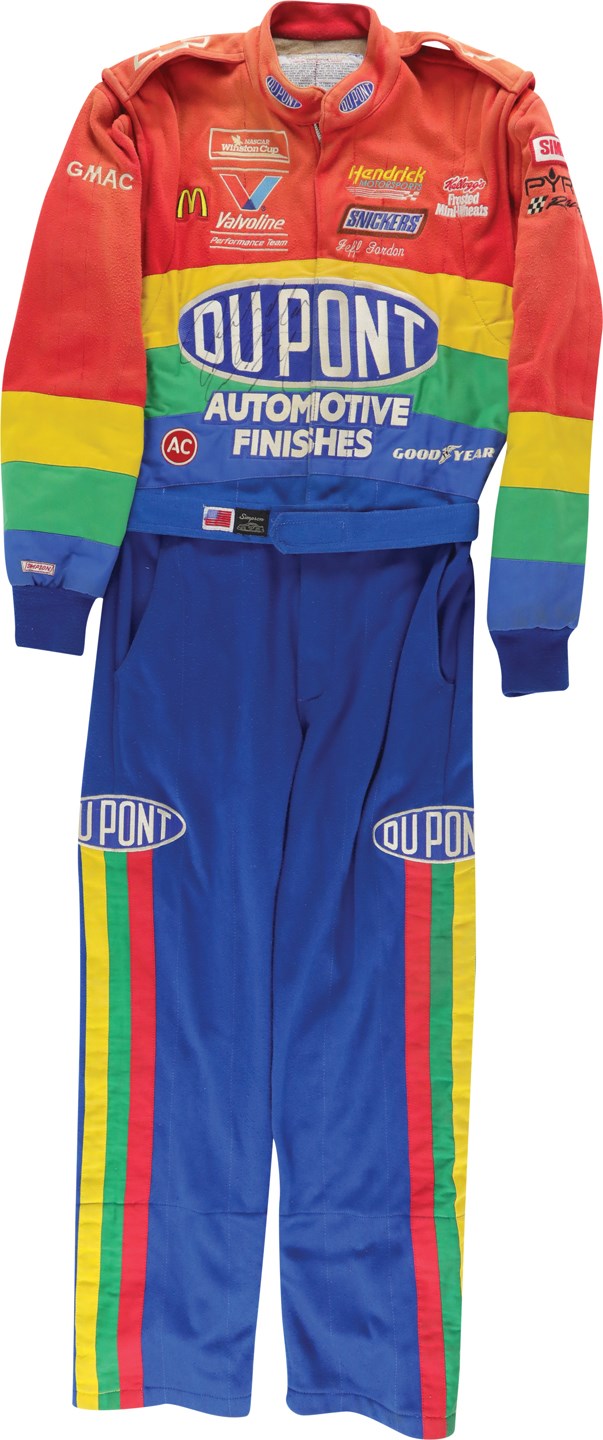
Olympics and All Sports
Lot # 1298: 1994 Jeff Gordon Photo-Matched Hooters 500 Signed Race Worn Fire Suit (Photo-Matched)A true legend in the sport of NASCAR, Jeff Gordon is not only a fan favorite, he was 1993 Rookie of The Year; 1995, 1997, 1998, and 2001 NASCAR Winston Cup Champion; won three Daytona 500s and five Brickyard 400s. Jeff Gordon began driving the No. 24 car full-time in the 1993 Winston Cup season. With Ray Evernham serving as his crew chief, Gordon started his rookie season by winning one of the Gatorade Twin 125s, becoming the youngest driver to win a Daytona qualifying race and placing fifth in the Daytona 500. Sourcing from his early days in NASCAR, this 1994 Simpson race suit is in Gordon's highly recognizable rainbow colored "DuPont" scheme, complete with all factory tagging, colorful patches and features "Hendrick Motorsports" and "Jeff Gordon" embroidery. Outstanding heavy wear noticed with pilling, fading, scuffs, some light staining and Gordon's large signature across the front on the "DuPont" embroidery. Photo-matched to 1994 Hooters 500 in Atlanta; Getty 110896782. Comes with PSA LOA.
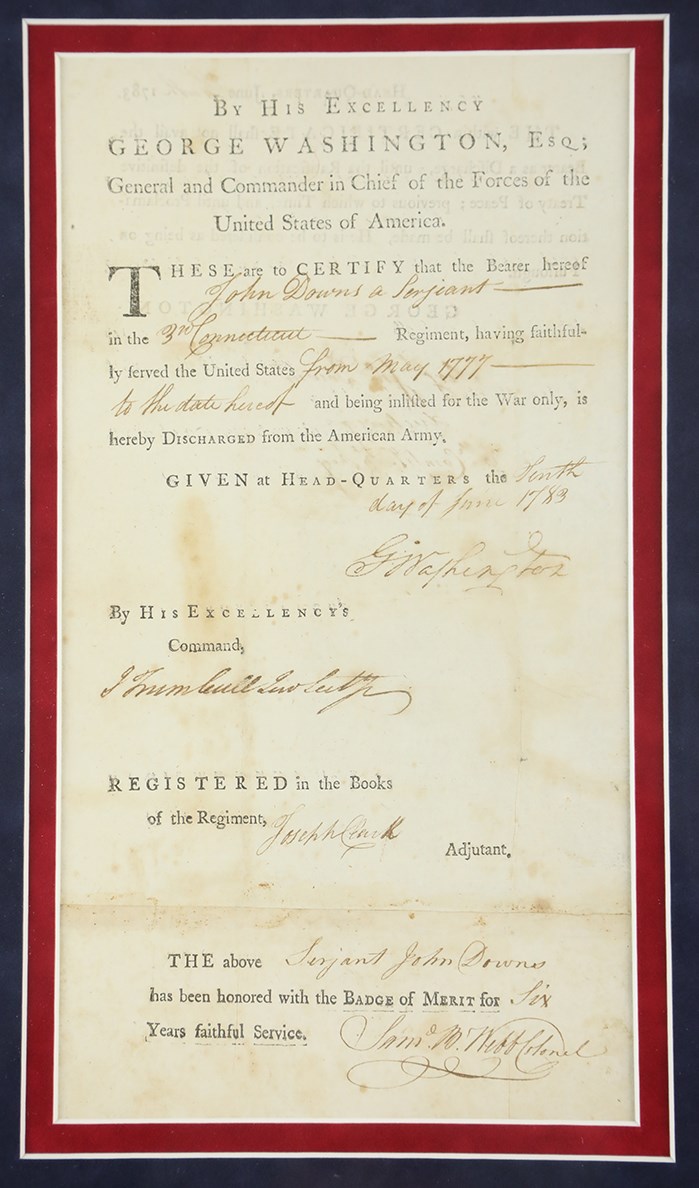
Historical Autographs
Lot # 480: 1783 George Washington Signed Discharge Papers (PSA)Presented are 1783 discharge papers from the American Army that are signed by George Washington. According to biographer, James Flexner, Washington was the "indispensable man" of the American Revolution. Certainly, the thirteen rebellious American colonies had intellectual brilliance in Thomas Jefferson, Benjamin Franklin, Patrick Henry, John Hancock, John and Samuel Adams, and many others, but what the Colonies needed in the Revolution was a man of action - and that man of action was George Washington. In Virginia, Washington had been a surveyor, and a wealthy planter, but what counted most in his experience was his time as an officer in the French and Indian War. Initially not an outstanding military strategist, Washington learned from his mistakes in the French and Indian War and in the earlier years of the American Revolution. Washington was 6'2", broad shouldered and muscular, and he loved outdoor pursuits like hunting and horseback riding. He was aggressive and his natural tendency in warfare was to attack. Yet, Washington was highly intelligent, and he was willing to listen to advice. When he took over as the first Commander in Chief of the Colonial Armies in 1775, he was in an almost untenable situation. His forces were more a collection of assorted state militias than a real army. Washington was outnumbered and outgunned against the professional British Army. Washington took counsel of his military advisors, and he was advised to avoid direct fighting with the British and to fight more of a hit-and-run guerilla action against the enemy. The American Revolution was a prolonged conflict - one that stretched from April 19, 1775, until September 3, 1783, a duration of eight years, four months, and 15 days. Yet, Washington stayed the course, risking possible execution as a British traitor if he was defeated. Washington fought a war that was not so much to conquer as to endure - to last long enough so that the British would tire of the long struggle and eventually abandon control of the American Colonies and let the Colonies rule themselves. From his defeat in New York, to the daring crossing of the Delaware River near Trenton, New Jersey, to the horrible, freezing conditions of a winter at Valley Forge, to the Colonials' triumph at Yorktown, Washington endured until the Colonies were victorious. The offered Continental Army discharge papers are for Sergeant John Downs of Connecticut, who served in the Army from 1777 until 1783. The discharge papers are signed by Washington (signing as G Washington) and his Chief of Staff John Trumbull. The discharge papers are framed so one can see the entire back of the letter on the back of the frame. This is a stunning document. The beginning of the document reads, "By His Excellency GEORGE WASHINGTON, Esq; General and Commander in Chief of the Forces of the United States of America. THESE are to CERTIFY that the Bearer Hereof John Downs a Sergeant in the 3rd Connecticut Regiment, having faithfully served the United States from May 1777 to the date hereof, and being inlisted (sic) for the War only, is hereby Discharged from the American Army. GIVEN at Head-Quarters the Ninth Day of June 1783." Washington signed his name in what appears to be blue ink from a fountain pen, with the ink fading over two centuries to an almost reddish color. At the bottom of the page, it is recorded that Sergeant Downs is honored with the Badge of Merit for Six Years faithful Service to the Army. The aforementioned discharge page measures 12.5x6.75". The display also includes two 3.5x4" images of paintings of Washington, both depicting him on horseback. The display also includes a 3.25x2.5" plaque that reads, "George Washington (1732-1799) Army discharge papers of Sgt. John Downs, dated June 9, 1783, signed by Washington as "General and Commander in Chief" and co-signed by his aide, John Trumbull. Overall, the entire display is matted and framed to 20x20.5". On the back of the discharge papers is a fascinating continuation of the front side of the document. This side of the discharge papers states that the "CERTIFICATE shall not avail the Bearer as Discharge until ratification of the definitive Treaty of Peace...and until Proclamation therefore be made, he shall be considered on Furlough." Thus, it is apparent that the Revolutionary War was on the verge of ending, and Sergeant Downs could go home, technically on furlough until the "official" end of the war, which turned out to be on September 3, 1783. The George Washington signature and accompanying display make a wonderful collectible, with the signature of the American Revolution's "indispensable man" set amidst great context and a gorgeous display. Comes with PSA LOA.

Historical Autographs
Lot # 485: Stunning 1784 John Hancock Signed Document Display (PSA)Offered is a 1784 ship's register for the schooner named Friendship, magnificently signed by John Hancock as the Governor of the Commonwealth of Massachusetts. Hancock was one of the richest men in the American Colonies, deriving his wealth from his uncle, Thomas Hancock, an importer/exporter. John Hancock made use of his great wealth to financially help support the American Revolution. Hancock was a political protégé of Samuel Adams, although eventually a rift developed between the two politicians. Hancock served as the President of the Second Continental Congress, and he was the first and third Governor of the Commonwealth of Massachusetts. The ship's register measures 12.1x15.1". The ship's papers (register) show that the owner of the ship is Joseph Monill, of Bedford (Massachusetts). Along with the ship's register, the offered display contains a plaque that measures 2.75x3.25". The plaque reads, "John Hancock (1737-1793)/First signer of the Declaration of Independence, President of the Continental Congress, Patriot... Official ship's register, signed as Governor, with Seal of the Commonwealth of Massachusetts/July 13, 1784." The ship's register contains the iconic, large, flamboyant signature of John Hancock as the Governor of Massachusetts. The ship's register also has the Seal of the Commonwealth of Massachusetts, and the seal is very faded from the passage of time. The handwriting on the document is not in Hancock's hand. The document is framed so that one can see the back of the document as well. In addition, the display contains an image of a painting of Hancock, and an image of a painting of Hancock and other founding Fathers about at the signing of the Declaration of Independence. All of the above-mentioned items - the ship's register, the plaque and the two images of paintings, have been attractively matted and framed at 23.4x29". The lower part of the frame does have a small chip. The ship's register has four tiny holes, located at spots where the document was folded into 12 parts, and the fold lines are visible. The ship's register does exhibit some fading and foxing, and a few minor stains, but overall, the document is in good condition, particularly in view of its well-over two century age. It's an apocryphal story that John Hancock signed the Declaration of Independence in such a large, bold way because he said, "I want King George to be able to read it without his spectacles." Yet, the Hancock signature has long taken on the meaning of the word "signature" itself, i.e., "Place your John Hancock on this." Thus, a signature from one of America's Founding Fathers, big and bold in the way a Hancock signature should be, is sure to be an attention getter in any collection. To possess the "John Hancock" of John Hancock? It's a prize for any collector. Comes with PSA LOA.

Historical Autographs
Lot # 486: 1801 Thomas Jefferson Signed Ship's Passport as President (PSA)Presented is a beautiful display featuring an 1801 ship's passport signed by Thomas Jefferson, as President. Jefferson, in his support of freedom of religion, thought, and speech, was one of the primary advocates for American independence from England. He was the chief author of the Committee of Five charged with formulating the American Declaration of Independence. Jefferson was the nation's first Secretary of State, under George Washington, and later Jefferson was the second Vice President of the United States, serving under John Adams' Presidency. Jefferson is also credited with helping to secure the purchase of Louisiana from France. The ship's passport is parchment, and the passage of time has affected some of its original measurements, but it now measures approx. 17.5x19,5", with the height measurement being to the highest point on top. The display includes a 3x5.5" plaque, which reads, "A Ship's Passport for the Ship Henry of Salem, John Barton master or commander, signed ("Th. Jefferson) as President, countersigned by Levi Lincoln as Acting Secretary of State and executed in Salem and Beverly, Massachusetts by Joseph Hiller, a Collector. Washington, July 17, 1801 1 page, Folio, 466x300 mm (18x11&3/4") on Parchment." The display also contains a 5.4x6.25" image of Jefferson. All of the foregoing is matted and framed at 27.25x28.38" The beginning of the passport reads, "By the President of the United States of America/Suffer the Ship Henry of Salem, John Barton master or commander of the burden of one hundred and ninety tons or thereabouts, mounted with four guns, navigated with fourteen men TO PASS with her company." The Presidential Seal is affixed, and the seal's color has faded over the more than two centuries since the document was executed. Some crinkling and shrinkage has occurred in the bottom left corner of the passport, near the seal. There are fold lines from when the document was at one time folded into six parts. The document is dated July 7, 1801. Jefferson's gorgeous signature, in ink, rates an 8/10. Overall, especially in view of the age of the passport, the document is in very good condition, and it makes an attractive, appealing remembrance of Jefferson, one of America's Founding Fathers. Comes with PSA LOA.
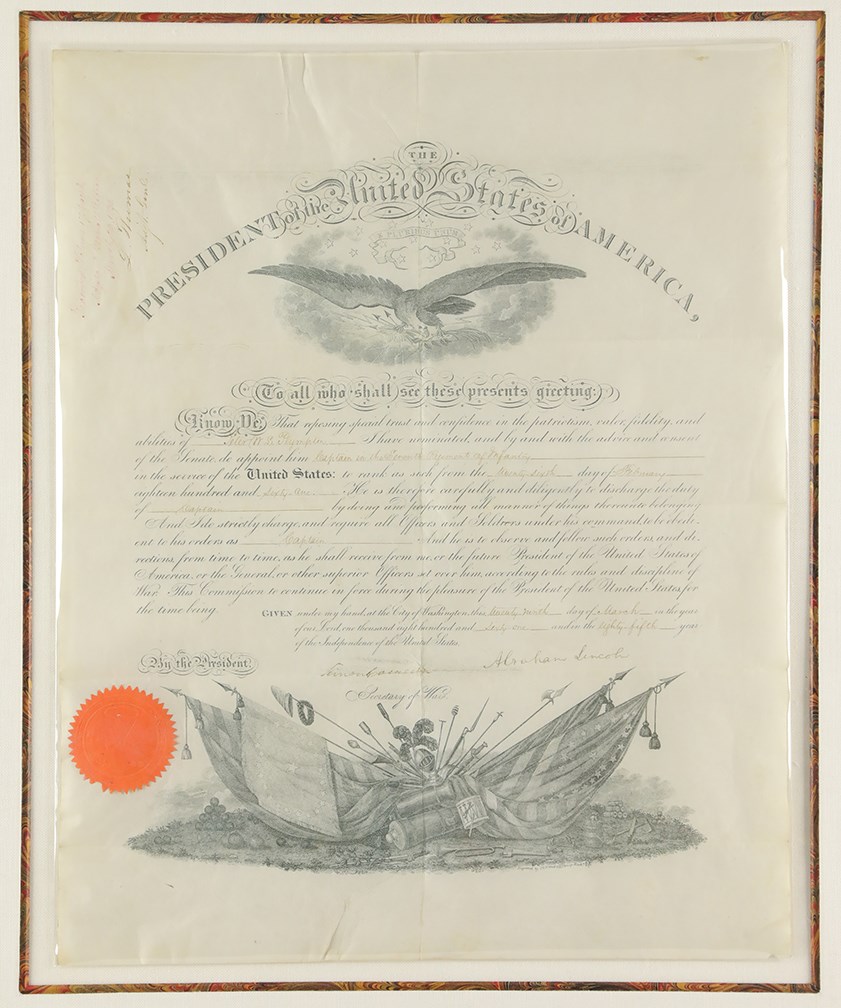
Historical Autographs
Lot # 484: 1861 Abraham Lincoln Signed Military Commission as President (PSA)"If you have never failed, you have never lived," said America's 16th President, Abraham Lincoln, a man who had weathered many previous failures in his life (including losing eight elections in his career), and yet successfully guided the United States to victory in the American Civil War. Displayed is a military commission as a Captain in the U.S. Army presented to Peter Plympton, dated March 29, 1861 (only three weeks after Lincoln's inauguration). It has been beautifully signed by Lincoln, using his full name "Abraham Lincoln" in his signature. Lincoln was inaugurated as U.S. President on March 4, 1861. The country was in turmoil at that time because, after Lincoln's election and prior to his inauguration, seven southern states had already seceded from the Union: South Carolina, Florida, Mississippi, Alabama, Georgia, Louisiana, and Texas, and six of these states had declared themselves as a sovereign nation, The Confederate States of America, and had adopted a constitution. Even before Lincoln was inaugurated, the United States military was already recruiting and enlisting officers and men who would serve in an anticipated military struggle between the North and South. Thus, before he took office, Lincoln was preparing for possible military conflict with the South. Always a careful planner, Lincoln exhibited his preference for foresight when he said, "Give me six hours to chop down a tree, and I will spend the first four sharpening the axe." Hence, part of Lincoln's "sharpening the axe" was his military recruitment of military officers and men. In a game of "Cat-and-Mouse," with the fate of the country hanging in the balance, Lincoln's War Department kept recruiting the military, as did the government of the rebellious South, neither side wanting to initiate the fighting, preferring to have the other side blamed for starting an armed conflict. Finally, on April 12, 1861, South Carolina attacked the United States Army at Fort Sumpter, in South Carolina, and the actual Civil War followed. The signed commission measures 15x19.4". Included in the striking overall display is an approx. 4.25x6" black & white portrait photo of Lincoln and an approx. 1x4.1" plague that reads, "Abraham Lincoln 16th President of the United States 1861-1865." The Presidential Commission, the Lincoln photo and the small plaque have been matted and framed into a single display measuring 28x30.1". Lincoln's big and bold, neatly written signature was made with a fountain pen. Also signing the military commission was Secretary of War Simon Cameron, whose signature was also written with a fountain pen. The document has the red seal of the Department of War (with a diameter of approx. 2.25"). One of the many very small "points" on the seal is missing. There are folds in the commission from its once being folded into eighths, and there is some faded handwriting from a fountain pen (source unknown) in the upper right corner. Even with the aforementioned minor defects and some expected partial fading of the handwritten sections of the commission, the document and the entire display are in very good condition. This wonderful Lincoln signed military commission comes with a PSA LOA, and it is a fascinating, historical collectible.
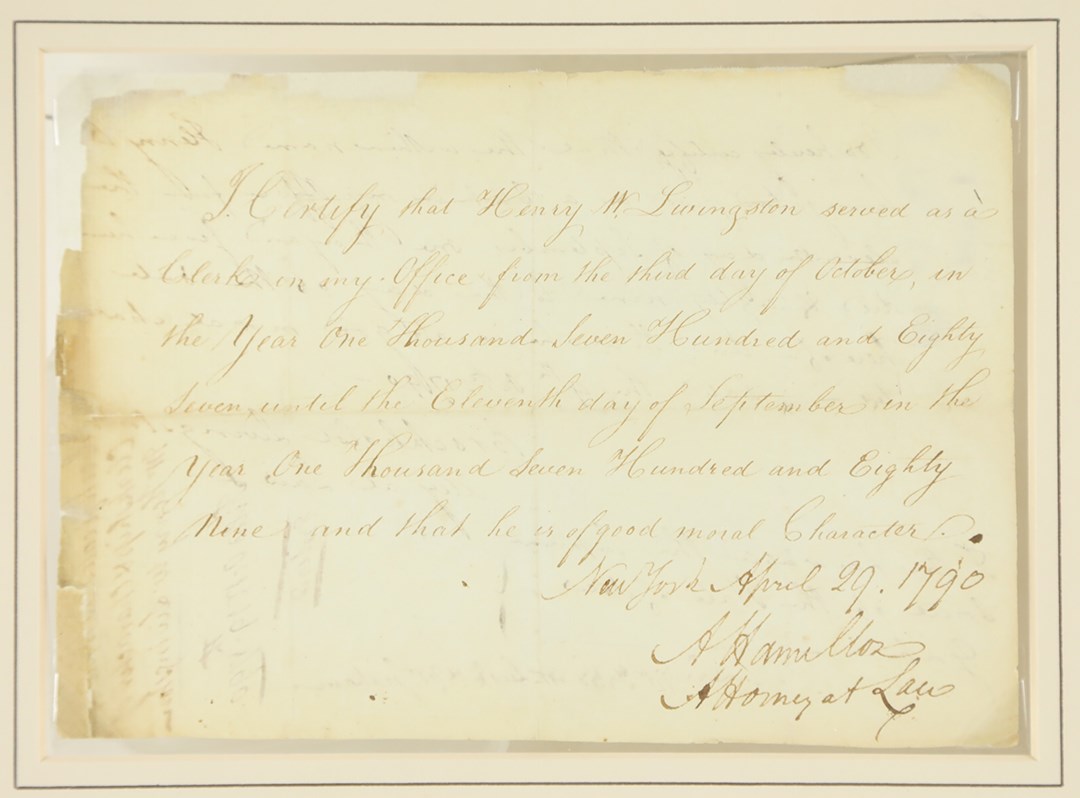
Historical Autographs
Lot # 481: 1790 Alexander Hamilton Signed Recommendation Letter as Secretary of the Treasury (PSA)Over two centuries old, this framed letter dated April 29, 1790, was signed by one of the USA's Founding Fathers, Alexander Hamilton. This is a letter of recommendation by Hamilton for one of his former law clerks, Henry Livingston, who was under consideration to be (and, in fact, became) a federal judge in New York. Text of the 8x5.75" (visible) letter was hand-written by a staffer and is extended on to the back, which is also visible through the glass backing. The letter is flowingly signed in black fountain ink along with the title "Attorney at Law." A 6.5x8.75" black and white portrait is on the right side, with page identifying the image also visible on back; fully-framed piece measures approximately 21.5x14.75". Note that there are touches to the left top corner and top edge of the letter, signs of a possible restoration, though the body of the letter remains intact. Though never elected President, Hamilton was the nation's first Secretary of the Treasury under President George Washington, and he is one of only seven men generally considered the nation's "Founding Fathers," including George Washington, John Adams, Benjamin Franklin, John Jay, Thomas Jefferson, and James Madison, making this a sensational piece dating to the earliest days of our fledgling nation. Comes with PSA LOA.
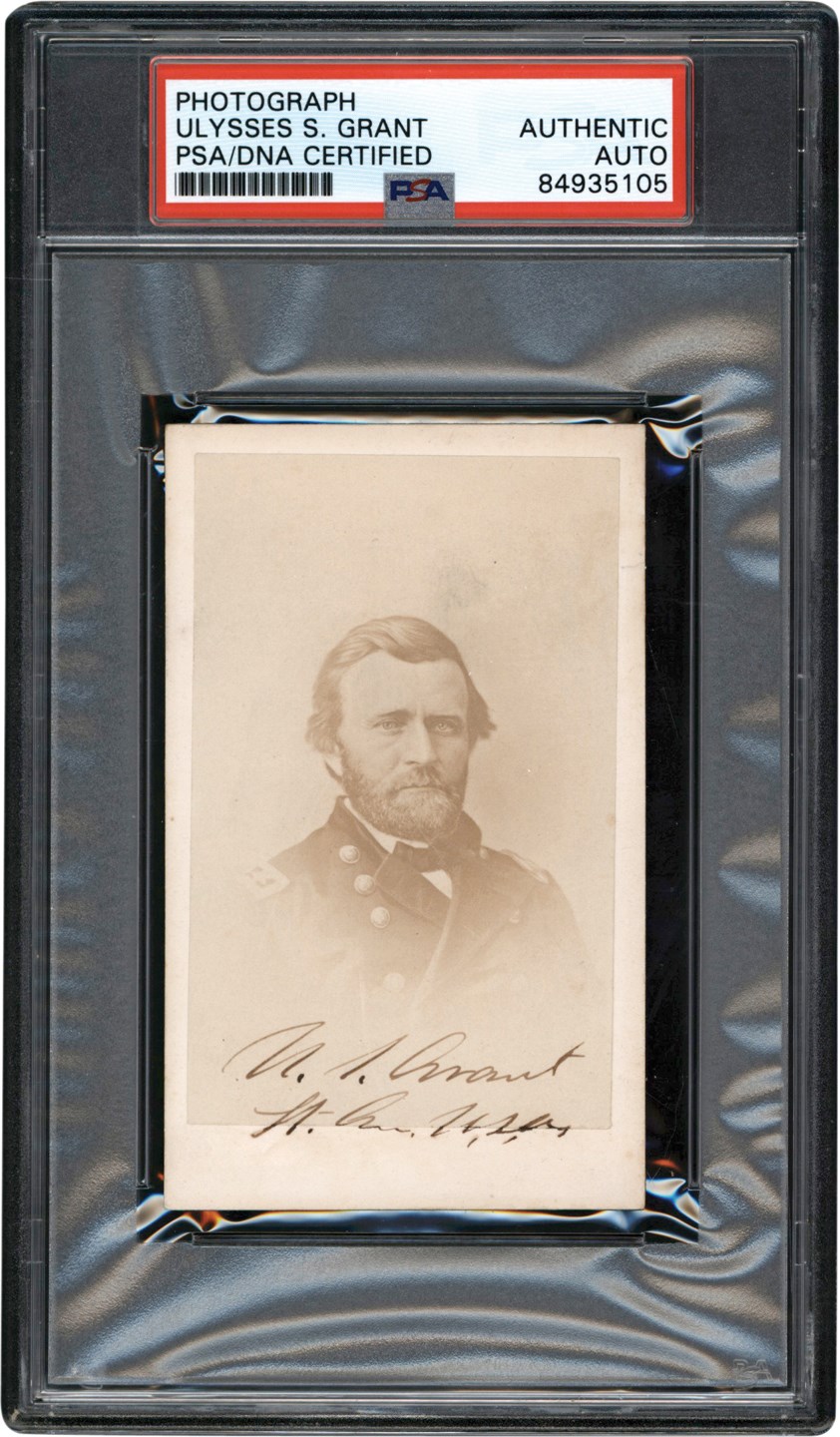
Historical Autographs
Lot # 488: 1860s Ulysses S. Grant Signed Carte de Visite as Lieutenant General (PSA)Incredibly scarce Carte de Visite of Ulysses S. Grant. Though he would proceed to become the 18th President of the United States, this CdV not only includes a photo and autograph from Grant, but it is also inscribed "Lt. Gen, USA." Grant was elevated to the rank of Lieutenant General by President Abraham Lincoln in 1864, leading the Union army to a defeat of the Confederate army in the Civil War, eventually propelling him to the White House. CdV measures 2.625x4"; a CdV was a kind of calling card for famous people in the 1800s, and due to the albumen nature of the image it has somewhat faded but image and black fountain ink signature remain quite clear and beautiful. Verso is blank except for manufacturing info by Brady & Co.'s National Photographic Portrait Galleries, and is clean except for a small spot of foxing at the very bottom. Tremendous history in this very rare piece, which has been encapsulated by PSA/DNA as Authentic Auto.

Historical Autographs
Lot # 489: 1860s Robert E. Lee Signed Carte de Visite (PSA)Incredibly scarce and magnificent circa 1860s carte de visite signed by Confederate general Robert E. Lee. Beautiful large signature in flowing black fountain rating 6/10 is across the bottom of this 2.5x4" specimen. Cream-colored card stock has an albumen portrait of the West Point graduate, who finished near the top of his class. Lee would eventually join the growing Confederacy and was noted as a skilled tactician who wanted the States to remain "United," though he followed the secession wishes of his home state of Virginia and was the Army of Northern Virginia's top general in the ill-fated Civil War. Front displays some handling wear and corners are slightly rounded; back is blank except for additional signs of handling and a small brighter patch, possibly from the removal of a piece of tape. Considering its century-and-a-half vintage it remains in exceptional condition, rating Very Good-Excellent overall. Encapsulated by PSA/DNA as Authentic Auto.
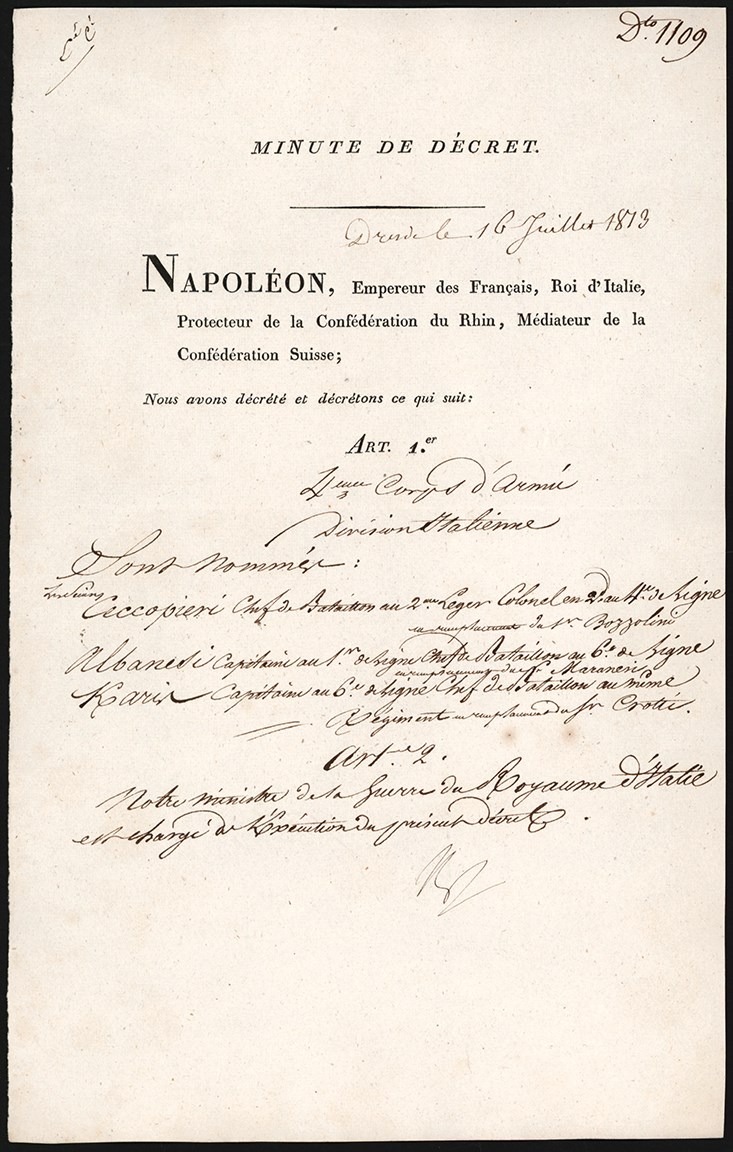
Historical Autographs
Lot # 487: 1813 Napoleon Bonaparte Signed Reinforcements Document Three Weeks Prior to The Battle of Leipzig (PSA)Amazing historically significant decree dating from 1813 signed by legendary French military commander Napoleon Bonaparte. A combination of printing and writing is present on this 7.75x12.75" missive on heavy paper stock, with the French-language printing leaving indentations visible on the back and translating to "Napoleon, Emperor of the Francis, King of Italy, Protector of the Rhine Confederation, Mediator of the Swiss Confederation, We have decreed and decree the following:" The order is on Grand Armee letterhead and introduces Napoleon (in French) by his many titles, with hand written information in black fountain ink below starting with "4th Corps d'Armee, Division Italienne." Signed by Napoleon on the bottom, the order was created three weeks before the Battle of Leipzig, which saw Prussian and Austrian troops combine with Russian forces to defeat the French, leading to the invasion of France resulting in Napoleon's abdication in 1814. Page remains in spectacular condition, particularly in light of its age and significance, and has one horizontal fold in the middle. Note that only the signature is in the hand of the French leader. Comes with PSA LOA.
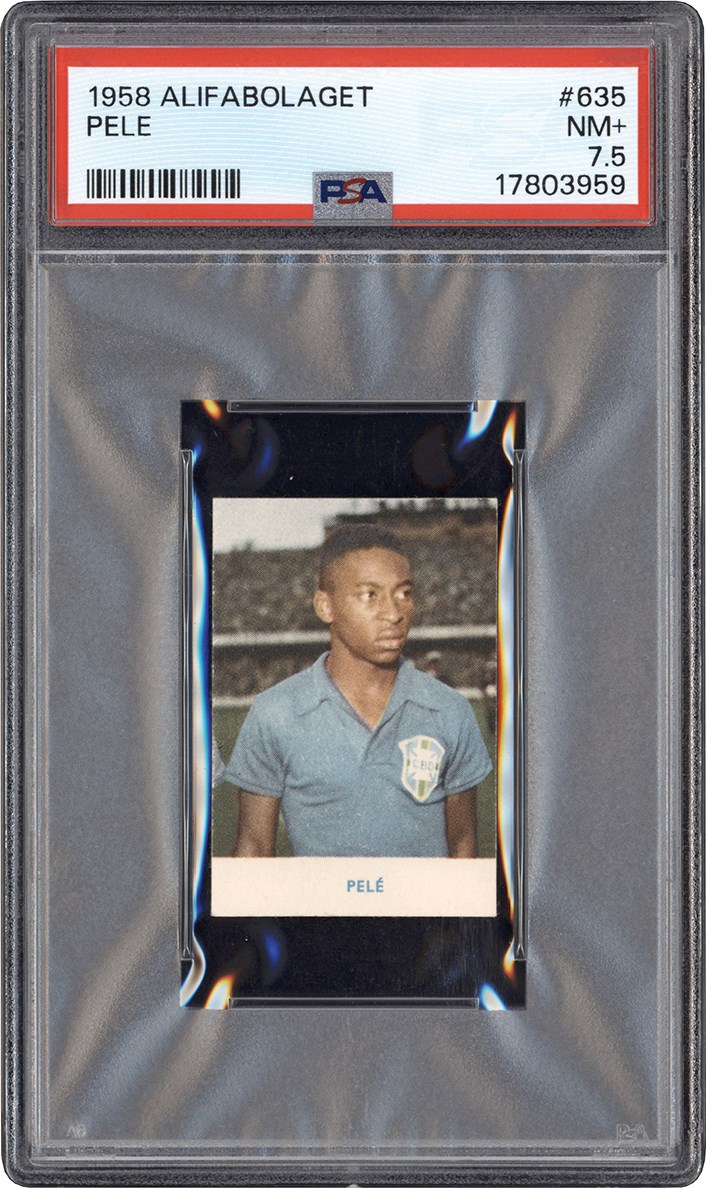
Baseball and Trading Cards
Lot # 1: 1958 Alifabolaget #635 Pele Rookie PSA NM+ 7.51958 Alifabolaget #635 Pele (R) Brazil National Team card. The card has been graded and encapsulated by PSA NM+ 7.5. It has a clear and colorful image of Pele with a filled stadium background. All four corners appear sharp and the edges are smooth. Centering is slightly off left to right. The reverse is bright and clean. According to the PSA population report a total of 120 cards have been graded with only 15 attaining a higher grade. The remaining cards in this set are available in a separate lot in this auction.

The Babe Ruth Sale Archive
Lot # 7: December 26th, 1919, Cancelled Promissory Note from New York Yankees to Red Sox for the Sale of Babe Ruth (ex-Barry Halper Collection)Cancelled promissory note in the amount of $25,000, dated December 26, 1919, issued by the New York Yankees to the Boston Red Sox for the purchase of Babe Ruth's contract. Signed on the front and reverse by New York Yankees owners Jacob Ruppert and T. L. Huston, and on the reverse by Boston owner Harry Frazee.
This is the original third and final promissory note issued by the New York Yankees for the purchase of Babe Ruth's contract in 1919, which was payable on November 1, 1922. Incredibly, as explained in the accompanying one-page typed signed letter, dated July 6, 1921, from Yankees owner T. L. Huston to Yankees general manager Ed Barrow, it was mistakenly cancelled due to a misunderstanding between Barrow and the bank. As one can plainly see, Barrow has cancelled the note by tearing away nearly all of both Ruppert's and Huston's signatures along the front base, and also crossed out their signatures on the reverse, along with the endorsement of Boston owner Harry Frazee.
In his letter, Huston instructs Barrow to have an identical promissory note drawn up, which he, Ruppert, and Frazee would sign, and which would then be held in the Yankees' safe. That replacement note, which became the note of record to complete the sale of Babe Ruth's contract, just recently sold in Leland's Spring Classic auction (Lot 746), where it realized $64,000. Both the promissory note and the Huston letter have been encapsulated by PSA, with all the respective signatures certified as authentic. The promissory note reads in part "On November 1st, 1922, We promise to pay to the order of The Boston American League Baseball Club Twenty Five Thousand Dollars and 00/100 at Federal Trust Company. Boston. Massachusetts. With interest at 6% per annum. American League Base Ball Club of New York." The note (7.75x3.25") displays the aforementioned tears along the base, a smaller edge tear, two paperclip impressions in the upper left corner, light toning, a staple hole and a vertical fold. The letter (8.5x11") displays two horizontal folds, a paperclip impression and several moderate creases.
The sale of Ruth, which is universally regarded as the most significant transaction in sports history, was necessitated by a number of factors, most important of which was Boston owner Harry Frazee's precarious financial footing at the time. Frazee purchased the Red Sox from Joseph Lannin in 1916 for $662,000. $400,000 was paid in cash, with the remaining $262,000 issued in the form of a note due on November 1, 1919. Unfortunately for Frazee, he was severely strapped for cash at the time the note came due. He was able to procure a few brief extensions from Lannin, but by the end of the year he was out of options. With no money to cover the note, he was forced to sell his most valuable asset: Babe Ruth.
The main suitors were the New York Yankees, with owners Jacob Ruppert and T. L. Huston only too happy to take the budding star off Frazee's hands. The deal was agreed upon on December 26, 1919. The Red Sox received $100,000 for Ruth, with $25,000 paid in cash and the remainder to be paid in yearly installments of $25,000, with each note due on November 1st of 1920, 1921, and 1922, respectively. In addition, the Yankees provided Frazee a loan of $300,000, with Fenway Park issued as collateral. Although the deal was agreed upon on December 26, 1919, it was not announced to the press until January 5, 1920, because the Yankees wanted to wait until they had renegotiated Ruth's contract. Once that was done, the greatest transaction in sports history was completed, and the fortunes of each franchise were reversed almost overnight.
This note, along with nearly every other surviving document relating to the sale of Babe Ruth to the New York Yankees, originates from the estate of Ed Barrow, who was manager of the Boston Red Sox at the time of the transaction, and soon after became the longtime business manager/general manager of the New York Yankees. Many years after Barrow's death, legendary collector Barry Halper purchased his entire business archive from the Barrow family, which included dozens of documents relating to Boston's historic sale of Ruth. (Barry Halper's collection is considered by many to have been the finest private baseball-memorabilia collection ever assembled.) In 1999, Halper sold nearly his entire collection at auction through Sotheby's in New York (the collection was so vast that it took over a week of twice-daily live auctions and three months of weekly internet sales to liquidate it). Lot 560 in the live-auction portion of the sale featured a large collection of documents relating to the sale of Ruth, from which this promissory note, as well as every other "sale of Ruth" document featured in this auction, originates. The entire content of Lot 560 in the 1999 Sotheby's Halper Collection auction has been consigned to our 2023 Spring and Summer Classic auctions by the original purchaser, making this just the third time since 1919 that these historically significant documents will have traded hands.
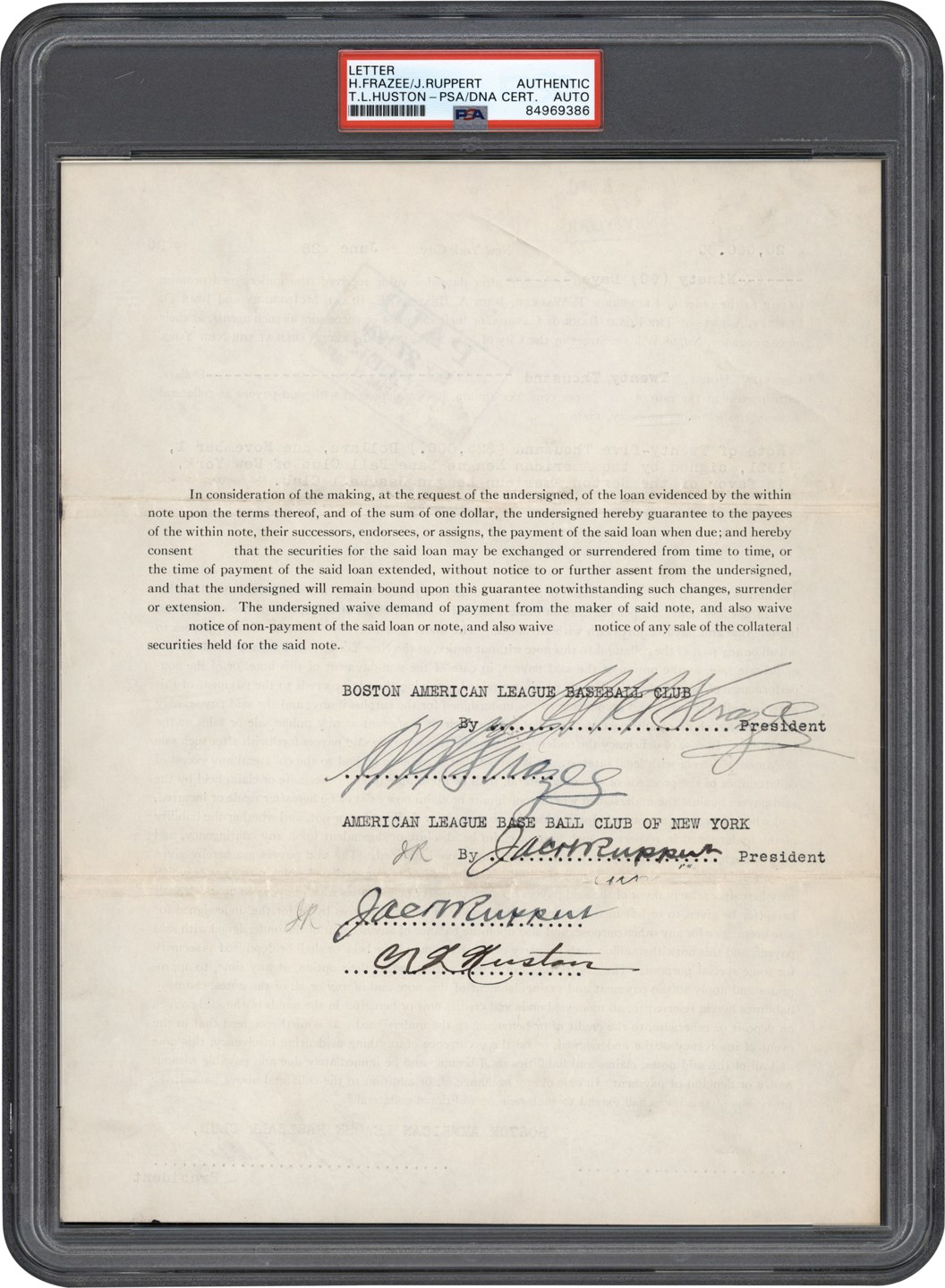
The Babe Ruth Sale Archive
Lot # 740: 1920 Harry Frazee Promissory Note Directly Relating to the Sale of Babe Ruth with Related Correspondence (ex-Barry Halper Collection)Promissory note in the amount $20,000, issued by Boston Red Sox owner Harry Frazee to The Royal Bank of Canada on June 28, 1920, signed three times by Frazee, twice by New York Yankees owner Jacob Ruppert, and once by New York Yankees co-owner T. L. Huston. Encapsulated by PSA, with each of the signatures certified as “Authentic.” According to the terms of the note, Frazee is to repay the Bank of Canada $20,000, plus six percent interest per annum, in ninety days.
This note has great historical significance because as collateral for the loan, Frazee puts up one of the $25,000 promissory notes he received from the New York Yankees as part of the purchase price for Babe Ruth’s contract three months prior. Frazee has signed the one-page document three times in blue fountain pen; once on the front in acceptance of the main terms of the loan, and twice on the reverse, in acceptance of additional terms. The note has also been signed on the reverse twice in black fountain pen by Yankees owner Jacob Ruppert and once in green fountain pen by Yankees co-owner T. L. Huston. (The signatures average 8/10.) The note (8.5x11”) displays two horizontal folds, a few light creases, and several light pencil notations. In Very Good condition overall.
Accompanying the note are several related documents (5): two file-copy letters (dated 6/26/20 and 6/29/20, respectively) representing correspondence from the Boston Red Sox to the Royal Bank of Canada concerning the note; two letters (dated 6/25/20 and 6/30/20, respectively) from the Royal Bank of Canada to T. L. Huston of the New York Yankees; and a small June 23, 1920, calendar page with handwritten pencil notes by a member of the Boston Red Sox front office.
To fully understand the material in this collection we must go back nearly six months. Harry Frazee sold Babe Ruth's contract to the Yankees on December 26, 1919, because he was in desperate need of cash. He owed $262,000 on an outstanding note to former Boston Red Sox owner Joseph Lanin, from whom he purchased the club, he needed to contribute $100,000 in cash equity for a theater he was purchasing, and his most recent theatrical productions were in the red. Even after the sale of Ruth's contract to the Yankees for $100,000 and a $300,000 loan on December 26, 1919, Frazee was still strapped for cash.
One of Frazee's problems centered around still unsettled issues with his original Fenway Park mortgage. Until that matter was settled he could not avail himself of the Yankees $300,000 loan (Fenway Park was listed as collateral for the loan). Also, the $100,000 that Frazee received from the Yankees was not in one lump sum. Frazee agreed to take $25,000 in cash, with the remainder to be paid in three notes of $25,000, each coming due, respectively, on November 1st over the next three years. The initial $25,000 that he received in cash was not nearly sufficient to cover his debts. Faced with this mounting financial pressure, Frazee immediately began borrowing money, using the three Yankees notes as collateral for his loans.
The New York Yankees owners Jacob Ruppert and T. L. Huston, as issuers of the original note, were instrumental in helping Frazee secure his loan from the Royal Bank of Canada. They were also responsible for paying the 6% interest per annum on the note, which is why their signatures appear on this note. The Frazee promissory note offered here was the third loan issued by the Royal Bank of Canada using the Yankees November 1, 1921, note as collateral. The first was issued on December 29, 1919, and the second was on March 27th. The note of June 28, 1920, agreement was in essence, a renewal of those prior agreements, except that the loan amount was reduced to $20,000 from $25,000.
These documents, along with nearly every other surviving document relating to the sale of Babe Ruth to the New York Yankees, originates from the estate of Ed Barrow, who was manager of the Boston Red Sox at the time of the transaction, and soon after became the longtime business manager/general manager of the New York Yankees. Many years after Barrow's death, legendary collector Barry Halper purchased his entire business archive from the Barrow family, which included dozens of documents relating to Boston's historic sale of Ruth. (Barry Halper's collection is considered by many to have been the finest private baseball-memorabilia collection ever assembled.) In 1999, Halper sold nearly his entire collection at auction through Sotheby's in New York (the collection was so vast that it took over a week of twice-daily live auctions and three months of weekly internet sales to liquidate it). Lot 560 in the live-auction portion of the sale featured a large collection of documents relating to the sale of Ruth, from which these documents, as well as every other "sale of Ruth" document featured this and our previous auction, originates.
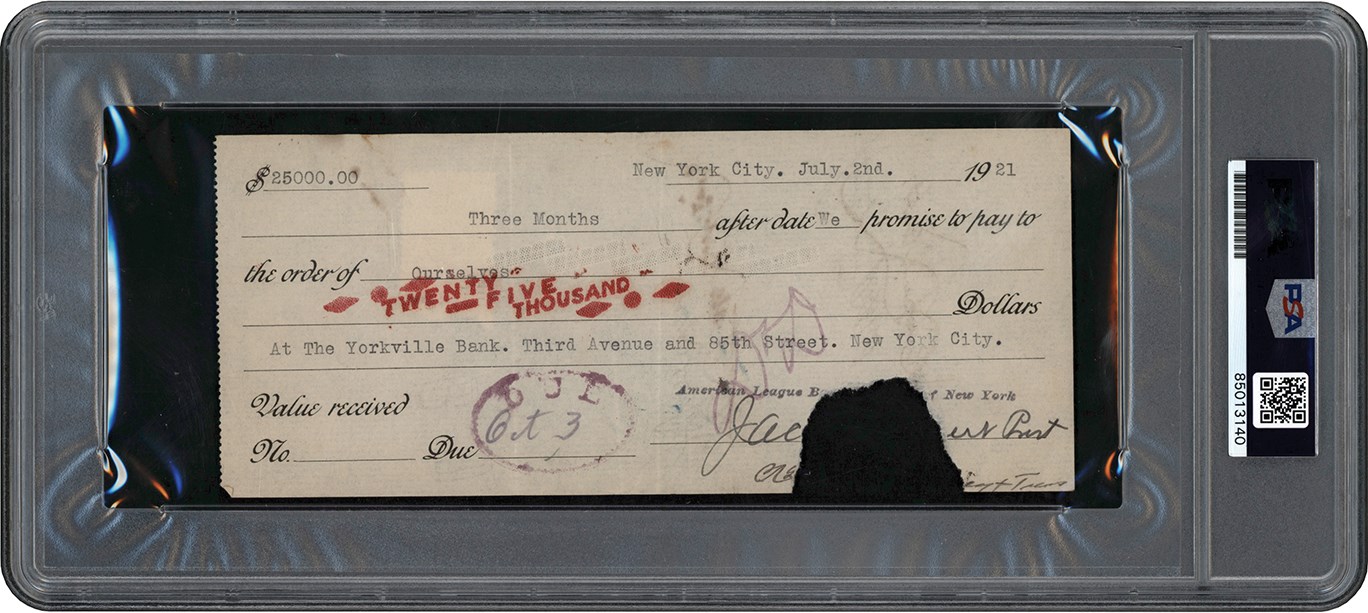
The Babe Ruth Sale Archive
Lot # 6: 1921 New York Yankees Cancelled Promissory Note Relating to the Sale of Babe Ruth and the Financing of Yankee Stadium (ex-Barry Halper Collection)Cancelled promissory note issued by the New York Yankees to themselves on July 2, 1921, directly relating to both the sale of Babe Ruth's contract on December 26, 1919, and financing for the construction of Yankee Stadium (which was built in 1923). Signed three times each by Yankees owners Jacob Ruppert and T. L. Huston. PSA has encapsulated the note and certified all the signatures as authentic. The three-month note, in the amount of $25,000, is made out to "Ourselves," but was later cancelled by Yankees general manager Ed Barrow, who tore out both the black-ink signatures of Ruppert and Huston on the front (small portions of each remain intact). Both Barrow and Huston endorsed the note twice on the reverse, but a small portion of one of the Ruppert signatures is affected by the tear.
The reason for the cancellation is made clear in a one-page typed letter, dated July 6, 1921, from Huston to Barrow, a photocopy of which accompanies the offered note. (The original letter is included as part of the cancelled 1919 New York Yankees promissory note to the Red Sox, which is featured elsewhere in this auction). The Yankees issued this note to themselves because Boston Red Sox owner Harry Frazee requested that the Yankees discount the third and final $25,000 promissory note for the purchase of Ruth's contract, which was payable by the Yankees on November 1, 1922. Frazee was desperate for cash at the time, and could not wait another ten months for the note to come due.
As the accompanying copy letter explains, the Yankees agreed to discount the note and decided to use the original note as collateral for a note to themselves. The Yankees were also facing a cash flow problem, and as Huston alludes to in his letter, they needed cash to finance the construction of Yankee Stadium. Unfortunately, the bank mistakenly instructed Barrow that it did not need the original promissory note that was being used as collateral, which caused Barrow to cancel both the original note and the Yankees related note offered here. The promissory note (7.75x3.25") displays the aforementioned tear in the lower right, a vertical fold, a paperclip impression, and a $5 stamp affixed to the reverse.
This note, along with nearly every other surviving document relating to the sale of Babe Ruth to the New York Yankees, originates from the estate of Ed Barrow, who was manager of the Boston Red Sox at the time of the transaction, and soon after became the longtime business manager/general manager of the New York Yankees. Many years after Barrow's death, legendary collector Barry Halper purchased Barrow's entire business archive from the Barrow family, which included dozens of documents relating to Boston's historic sale of Ruth. (Barry Halper's collection is considered by many to have been the finest private baseball-memorabilia collection ever assembled.) In 1999, Halper sold nearly his entire collection at auction through Sotheby's in New York (the collection was so vast that it took over a week of twice-daily live auctions and three months of weekly internet sales to liquidate it). Lot 560 in the live-auction portion of the sale featured a large collection of documents relating to the sale of Ruth, from which this note, as well as every other "sale of Ruth" document featured in this auction, originates. The entire content of Lot 560 in the 1999 Sotheby's Halper Collection auction has been consigned to our 2023 Spring and Summer Classic auctions by the original purchaser, making this just the third time since 1919 that these historically significant documents will have traded hands.
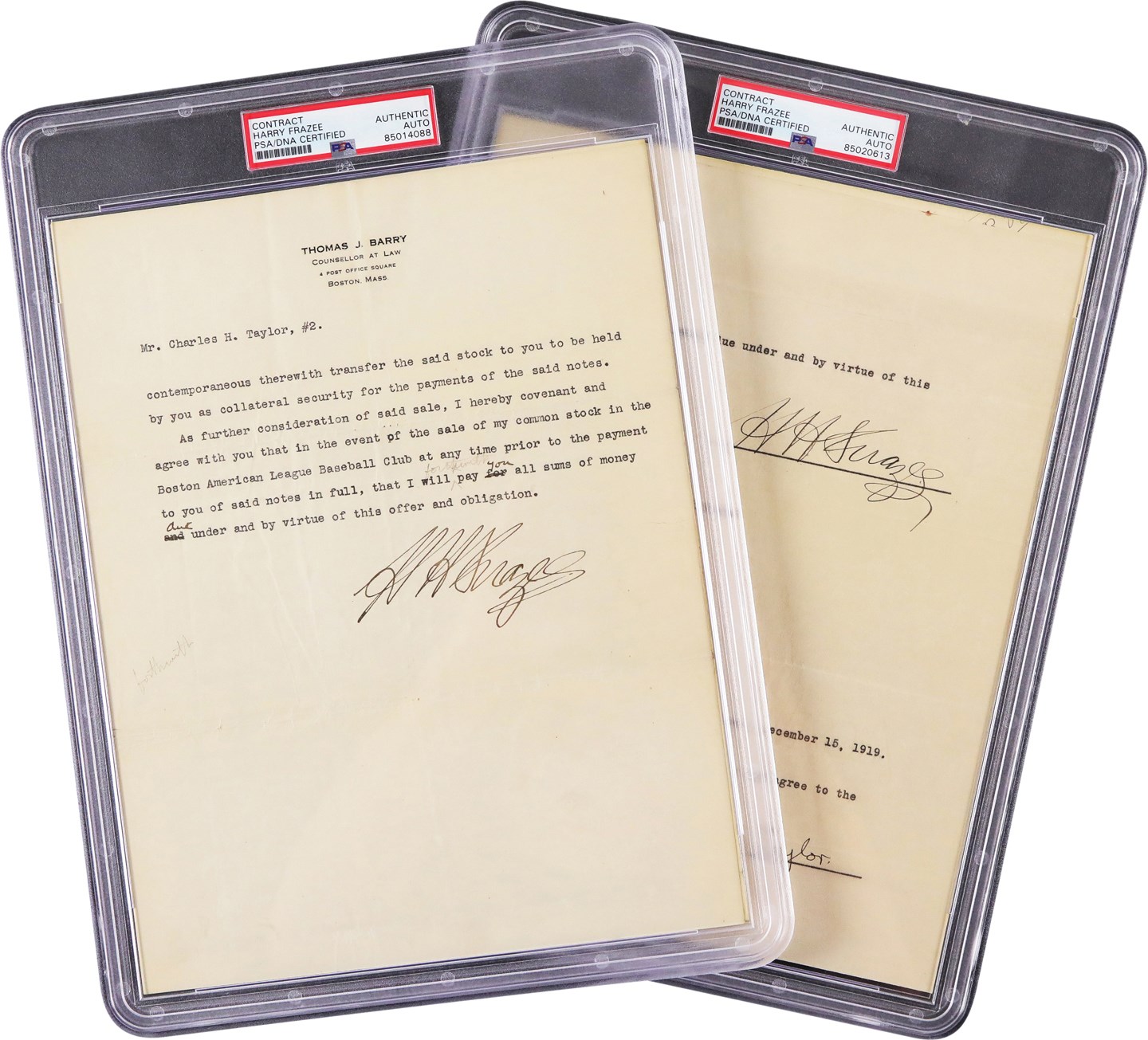
The Babe Ruth Sale Archive
Lot # 743: 1919 Harry Frazee Signed Purchase Agreement for 1,500 Shares of Boston Red Sox Preferred Stock – Prelude to the Sale of Ruth’s Contract (ex-Barry Halper Collection)Two-page typed agreement, dated December 15, 1919, between Red Sox majority owner Harry Frazee and Charles Taylor, in which Frazee agrees to purchase Taylor's 1,500 shares of preferred stock of the Boston American League Baseball Club. The agreement calls for Frazee to pay Taylor $150,000 for the shares, plus an additional $13,500 in both paid and unpaid dividends due to him. Signed in black fountain pen (grading 9/10 overall) by both Frazee and Taylor, plus a witness.
The purchase of Taylor's shares of preferred stock was necessary for Frazee in order to ultimately obtain full ownership of Fenway Park, which was to be used as collateral for a $300,000 loan he hoped to receive from the New York Yankees. The loan was an integral part of the deal for the sale of Babe Ruth's contract, along with $100,000, which occurred on December 26, 1919. Accompanying the agreement is a two-page typed letter, dated December 15, 1919, from Thomas Barry, Frazee's attorney, which represents the original draft of the agreement. Frazee made several changes to the agreement in black ink, and signed the final page in black fountain pen (grading 9/10). Both the final agreement (8.5x13") and draft letter (8.5x11") display several horizontal folds and light creases. The agreement is marked "Duplicate" in black ink in the upper left corner. Both documents have been encapsulated by PSA, with the Frazee signatures each certified as "Authentic."
This letter, along with nearly every other surviving document relating to the sale of Babe Ruth to the New York Yankees, originates from the estate of Ed Barrow, who was manager of the Boston Red Sox at the time of the transaction, and soon after became the longtime business manager/general manager of the New York Yankees. Many years after Barrow's death, legendary collector Barry Halper purchased Barrow's entire business archive from the Barrow family, which included dozens of documents relating to Boston's historic sale of Ruth. (Barry Halper's collection is considered by many to have been the finest private baseball-memorabilia collection ever assembled.) In 1999, Halper sold nearly his entire collection at auction through Sotheby's in New York (the collection was so vast that it took over a week of twice-daily live auctions and three months of weekly internet sales to liquidate it). Lot 560 in the live-auction portion of the sale featured a large collection of documents relating to the sale of Ruth, from which this letter, as well as every other "sale of Ruth" document featured in our previous auction, originates.
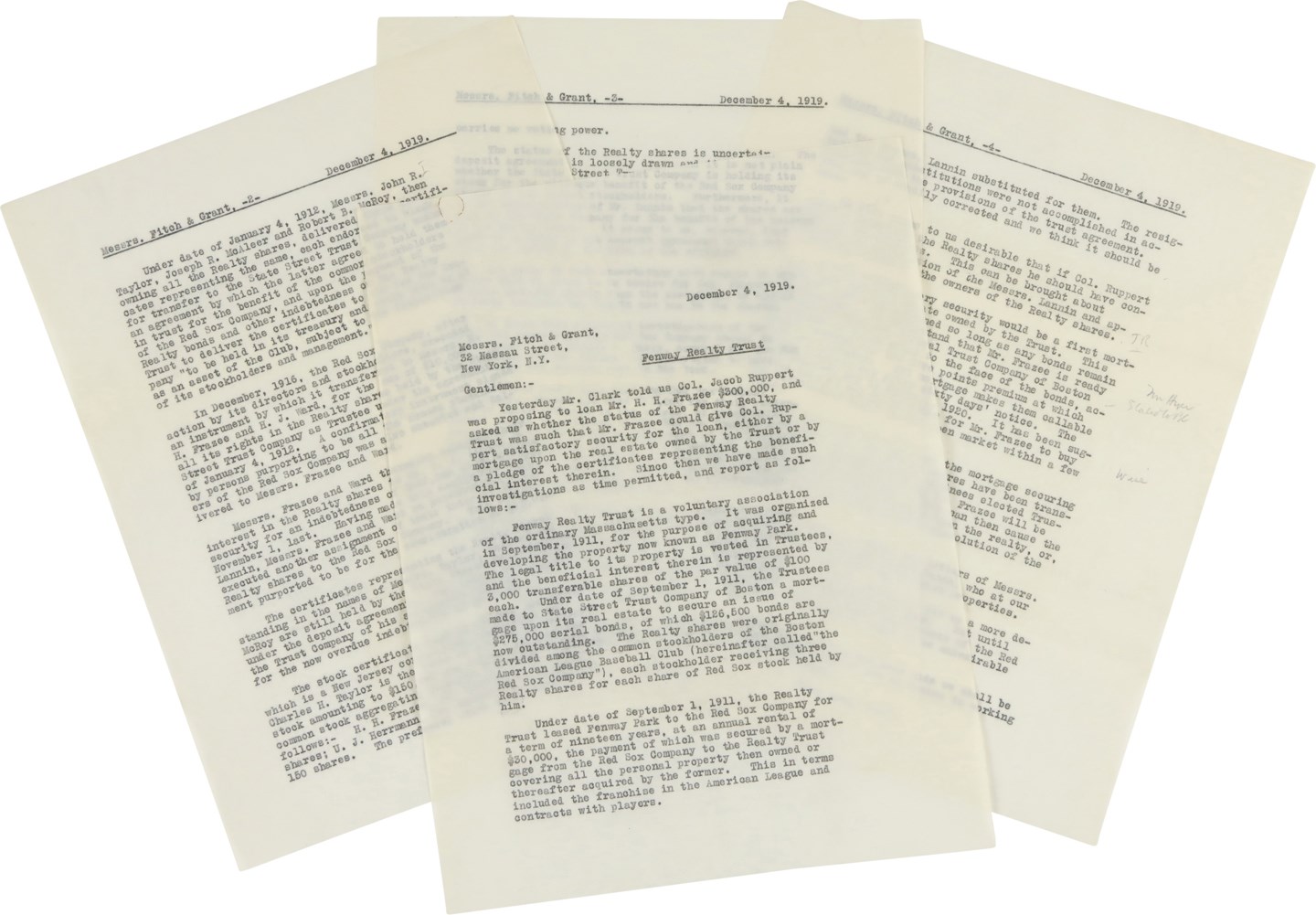
The Babe Ruth Sale Archive
Lot # 742: 1919 NY Yankees $300,000 Loan Analysis Copy Letter for the Sale of Babe Ruth’s Contract (ex-Barry Halper Collection)Important four-page file-copy letter, dated December 4, 1919, concerning a $300,000 loan by the New York Yankees to Boston Red Sox owner Harry Frazee, which was central to the eventual sale of Babe Ruth's contract just three weeks later.
As one can see by this letter, which was prepared for Yankees owners Col. Jacob Ruppert and T. L. Huston, the negotiations for the sale of Ruth's contract took place not only months prior to the consummation of the deal on December 26, 1919, but under a tight veil of secrecy. Harry Frazee sold Ruth's contract for $100,000 ($25,000 payable up front, with the remainder in the form of three $25,000 promissory notes, due annually over the next three years), which was a large sum of money, but not nearly enough to pay off his debts. To close the deal, he insisted on the Yankees extending him a $300,000 loan. The Yankees, naturally, required collateral for the loan, and the only thing Frazee could offer was Fenway Park. The problem, however, was that it was unclear to both parties if Frazee had complete ownership of Fenway Park at the time.
This letter, written by the law firm Fitch & Grant (the corporate attorney for the New York Yankees), provides a detailed analysis regarding the ownership of Fenway Park. As reported here, Frazee's ownership status was uncertain, and the firm advises "that it seems to us unwise for Col. Ruppert to advance $300,000 merely upon the assignment to him of whatever interest Mr. Lannin now has in the shares." However, the firm does believe that the matter can be satisfactorily achieved with more research, adding "We think a careful investigation of the books and records of the Red Sox Company should be first made. Mr. Thomas J. Barry, counsel for the Red Sox Company and Mr. Frazee, has undertaken to have these books and records sent to New York."
As we know today, the issues addressed in this letter were all resolved and the Yankees did make the loan to Frazee. What makes this letter especially interesting is that there was no mention at all about why the Yankees were even considering loaning Frazee the money. Because of Ruth's status at the time, and the media frenzy that would have ensued should news of the possible sale of his contract leak out, all the negotiations between the Yankees and Red Sox were conducted in the strictest of secrecy, with only the owners aware of the deal.
Each page of the file-copy letter (8.5x11"), written on onion skin and not signed, displays two horizontal folds, with the last two pages displaying several small handwritten pencil notes in the border areas.
This letter, along with nearly every other surviving document relating to the sale of Babe Ruth to the New York Yankees, originates from the estate of Ed Barrow, who was manager of the Boston Red Sox at the time of the transaction, and soon after became the longtime business manager/general manager of the New York Yankees. Many years after Barrow's death, legendary collector Barry Halper purchased Barrow's entire business archive from the Barrow family, which included dozens of documents relating to Boston's historic sale of Ruth. (Barry Halper's collection is considered by many to have been the finest private baseball-memorabilia collection ever assembled.) In 1999, Halper sold nearly his entire collection at auction through Sotheby's in New York (the collection was so vast that it took over a week of twice-daily live auctions and three months of weekly internet sales to liquidate it). Lot 560 in the live-auction portion of the sale featured a large collection of documents relating to the sale of Ruth, from which this letter, as well as every other "sale of Ruth" document featured in this and our previous auction, originates.
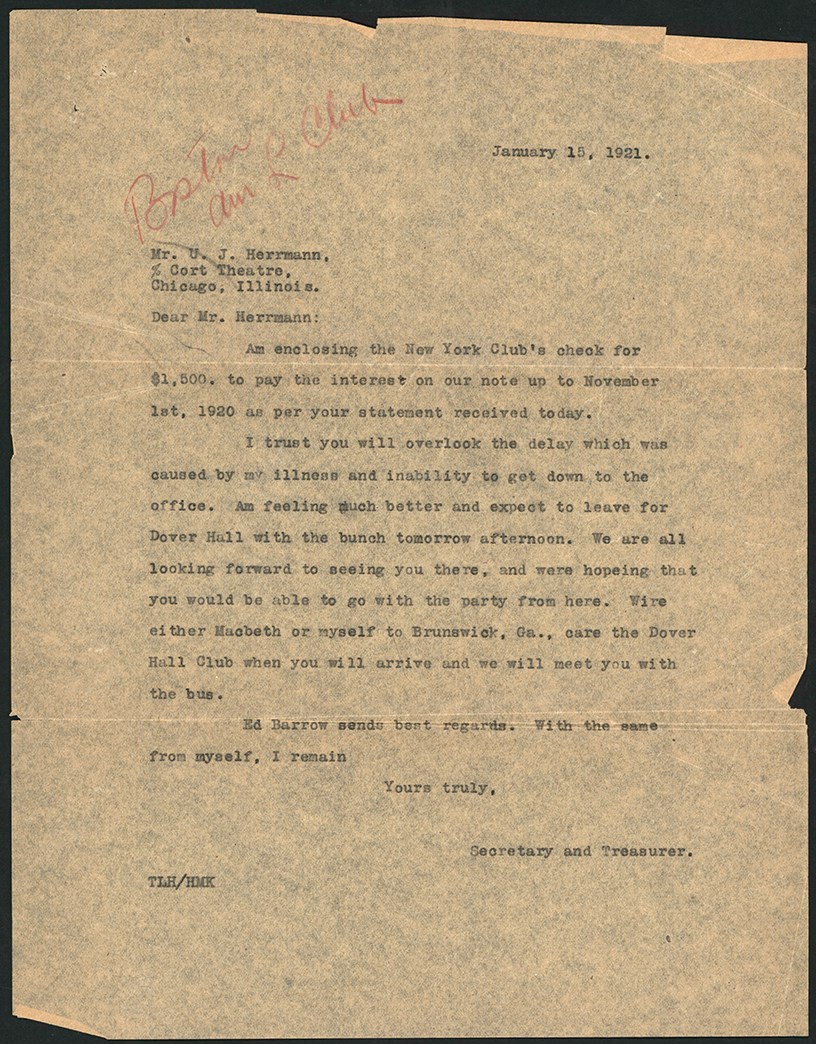
The Babe Ruth Sale Archive
Lot # 744: 1921 Letter from T. L. Huston to Red Sox Treasurer Referencing Interest on Payment for Babe Ruth (ex-Barry Halper Collection)One-page typed file-copy letter, dated January 15, 1921, from New York Yankees co-owner T. L. Huston to Boston Red Sox treasurer U. J. Herrmann, regarding the payment of interest on one of the promissory notes issued to the Boston Red Sox for the sale of Babe Ruth's contract. In his letter, Huston apologizes for the lateness of the payment, which was due to a recent illness he incurred.
On December 26, 1919, the New York Yankees purchased Babe Ruth's contract from the Boston Red Sox. The Red Sox received $100,000 for Ruth, with $25,000 paid in cash and the remainder to be paid in yearly installments of $25,000, with each note due on November 1st of 1920, 1921, and 1922, respectively. The Yankees also agreed to pay 6% interest per annum on each note. In addition, the Yankees provided Frazee a loan of $300,000, with Fenway Park issued as collateral. Although the deal was agreed upon on December 26, 1919, it was not announced to the press until January 5, 1920, because the Yankees wanted to wait until they had renegotiated Ruth's contract. Once that was done, the greatest transaction in sports history was completed, and the fortunes of each franchise were reversed almost overnight. The file-copy letter (8.5x10.75"), on onion skin, displays two horizontal folds, small edge tears and light creasing, and a handwritten notation in red pencil near the top border.
This letter, along with nearly every other surviving document relating to the sale of Babe Ruth to the New York Yankees, originates from the estate of Ed Barrow, who was manager of the Boston Red Sox at the time of the transaction, and soon after became the longtime business manager/general manager of the New York Yankees. Many years after Barrow's death, legendary collector Barry Halper purchased Barrow's entire business archive from the Barrow family, which included dozens of documents relating to Boston's historic sale of Ruth. (Barry Halper's collection is considered by many to have been the finest private baseball-memorabilia collection ever assembled.) In 1999, Halper sold nearly his entire collection at auction through Sotheby's in New York (the collection was so vast that it took over a week of twice-daily live auctions and three months of weekly internet sales to liquidate it). Lot 560 in the live-auction portion of the sale featured a large collection of documents relating to the sale of Ruth, from which this letter, as well as every other "sale of Ruth" document featured in this and our previous auction, originates.

Mantle and Maris
Lot # 769: 1951 Mickey Mantle MLB Debut Photograph w/DiMaggio & Williams (PSA Type I)Tremendous Type I photo from the Major League debut of New York Yankees immortal Mickey Mantle, along with teammate Joe DiMaggio and Boston Red Sox Slugger Ted Williams. Photo was taken just before Mick's first game with the Yankees, on April 17, 1951, an incredible shot of two established superstars along with a phenom who went on to join them in a Hall of Fame career. Photo has been trimmed to 5.125x7.875" and all three central images are crisp against a dark background. Verso has a triangle of age discoloration in the top left corner and is blank aside from an International News credit stamp. A similar, but different, Type I image (signed by Mantle) clearly from the same shoot sold for nearly $30,000 in our recent Spring Classic auction, though this is unsigned; it has been oft duplicated, but this is an original. Encapsulated by PSA as Type I Authentic, comes with PSA LOA.
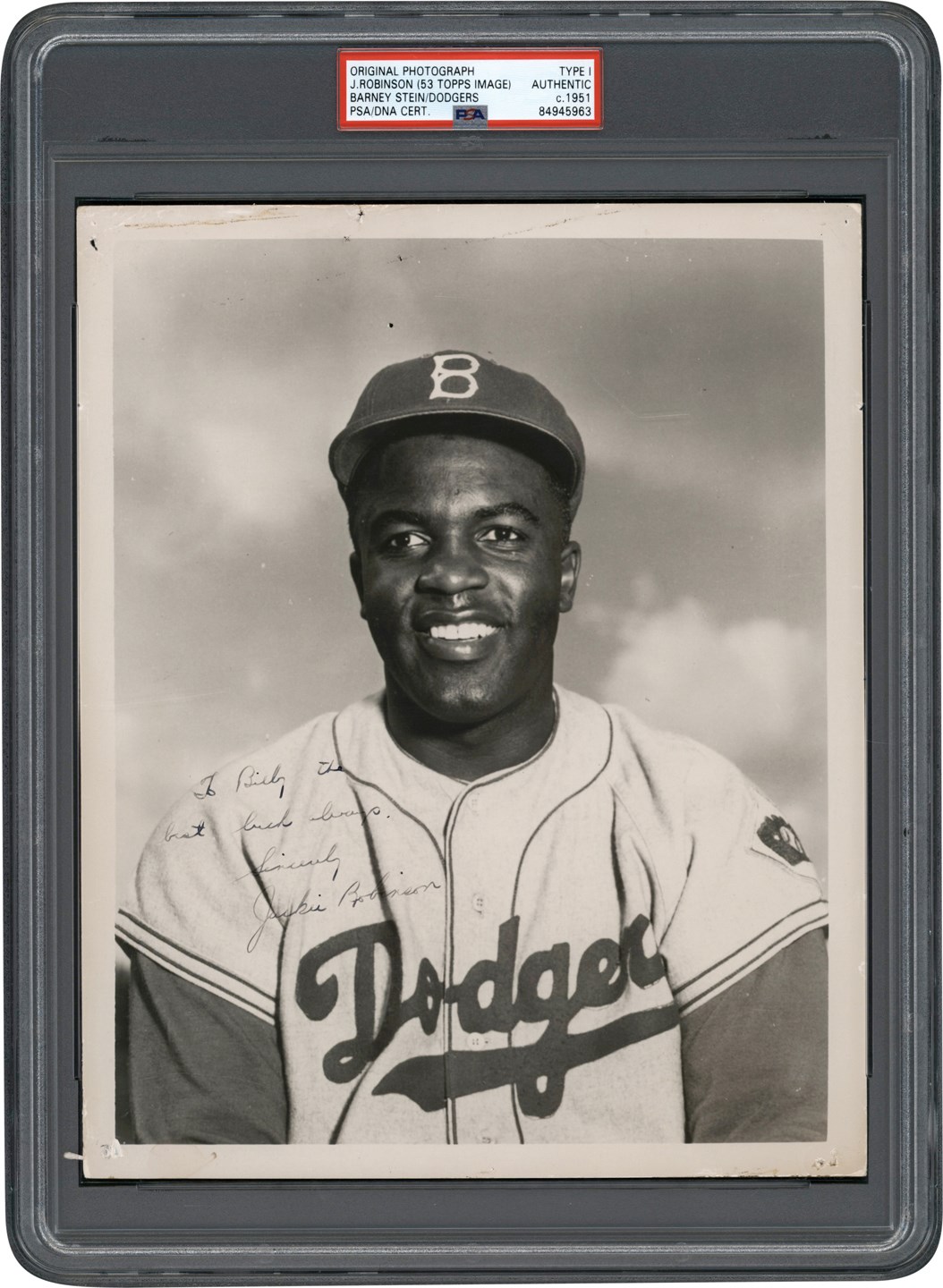
Jackie Robinson & Brooklyn Dodgers
Lot # 8: Circa 1951 Jackie Robinson Signed Original Photograph Used for 1953 Topps Card to Teammate Billy Cox (PSA Type I)Presented is a 1951 Jackie Robinson signed original 8x10" black & white photograph, taken by famed photographer Barney Stein, that was used by Topps for Robinson's '53 baseball card (#1), for the Topps set that featured baseball cards with original artwork made from original photos. Robinson was a magnificent ballplayer who batted .311 for his MLB career, all with Brooklyn. At his peak, in 1949 at age 30, Robinson was the National League MVP, won the NL batting crown by hitting .342, and took the NL stolen base title, with 37. Robinson's successful breaking of the "Color Line" was a seminal event in the history of America. The photo was signed and inscribed by Robinson and gifted to his Brooklyn Dodgers teammate Billy Cox, noted for his marvelous fielding at third base. What's particularly ironic is that in 1953, Robinson's range in the field had diminished, and in 1954, the Dodgers used three third basemen: Robinson played 50 games at third and more in left field; Don Hoak played 75 games at third; and Billy Cox played 57 games at third, plus occasional games at shortstop and second base. By 1955, the year the Brooklyn Dodgers won their only World Series, Cox had been sent to the Baltimore Orioles - where he played his final season - mainly because Robinson and Hoak were sharing time at third base. Thus, Robinson and Cox had been in competition for playing time at third base, and yet Robinson's inscription coveys his sincere good wishes for his long-time teammate. During his ten years with the Dodgers, Robinson was a regular at first base, second base, and third base, plus a semi-regular for two seasons as a left fielder. The offered photo was used by Topps in their 1953 baseball card set as the basis for an artistic rendering of each of the 274 included players. The large 2.625x3.75" Topps '53 cards featured lifelike colors and that made the cards wonderful visual collectibles, as the artwork was so lifelike that the cards seemed almost alive. About five different artists were used, and artist Gary Dvorak recalls being paid $25 per painting. Dvorak created about 50 of the paintings, using opaque watercolor paint. This offered signed photo contains Robinson's signature and inscription, using a fountain pen: "To Billy, the best luck always. Sincerely Jackie Robinson." The signature and inscription are clearly legible but have somewhat faded with the passage of time. The signed and inscribed circa 1951 photograph has been encapsulated and PSA/DNA certified as "TYPE I AUTHENTIC." This item comes from Billy's Cox's wife, who then gifted it to our consignor. The beautiful Jackie Robinson signature and its accompanying inscription to Billy Cox on this vintage photo that was the model for Robinson's 1953 Topps card is an item that will inspire interest and conversation in any sports collection.

Tickets, Publications & Pins
Lot # 4: 1954 Hank Aaron Major League Debut Ticket Stub PSA EX 5 (Pop 1 of 2 Highest Graded)"Hammerin' Hank" Aaron took his Major League baby steps on April 13, 1954, at Cincinnati's Crosley Field, hitting into a double play in his initial at-bat en route to an 0-for-5 collar. His Braves lost a slugfest to the Reds that afternoon, 9-8, and here's a ticket stub from the historic game that has been graded and encapsulated STUB EX 5 by PSA (Pop 1 of 2 Highest Graded). Aaron rebounded to bat .280 with a modest 13 home runs and 69 RBI that rookie campaign, and the rest - as they say - is history.

Vintage Sports Photographs
Lot # 1028: Circa 1954 Sandy Koufax Rookie Photograph - Earliest Photo in a Brooklyn Dodgers Uniform (PSA Type I)Historically significant original Type I photograph capturing Sandy Koufax wearing a Brooklyn Dodgers uniform for the first time. As noted in the accompanying LOA from PSA, this photo was taken on December 22, 1954, which is the day Koufax signed as a "Bonus Baby" with the Brooklyn Dodgers. It was also taken during the same photo shoot that produced the image used on Koufax's 1955 Topps rookie card. Koufax signed with the Dodgers for the league minimum salary of $6,000, but he also received a signing bonus of $14,000. Because his signing bonus amounted to $4,000 or more, league rules stipulated that Koufax had to remain on the Dodgers twenty-five man active Major League roster for two full seasons; otherwise he could be claimed off the waiver wire. While it turned out to be a good investment for the Dodgers, Koufax's first two years on the bench greatly hindered his development. As a result, he didn't begin to realize his full potential until 1961. The wait was certainly worth it for Dodgers fans, however, as Koufax won 129 games over the next six seasons (1961-1966) and led the Dodgers to three pennants and two World Championships. The photo (4x5"), which features Koufax's name written in pencil on the reverse, displays a few small creases in the lower right corner and is otherwise in Excellent condition. Encapsulated as Type I Authentic by PSA. Also accompanied by a full LOA from PSA.
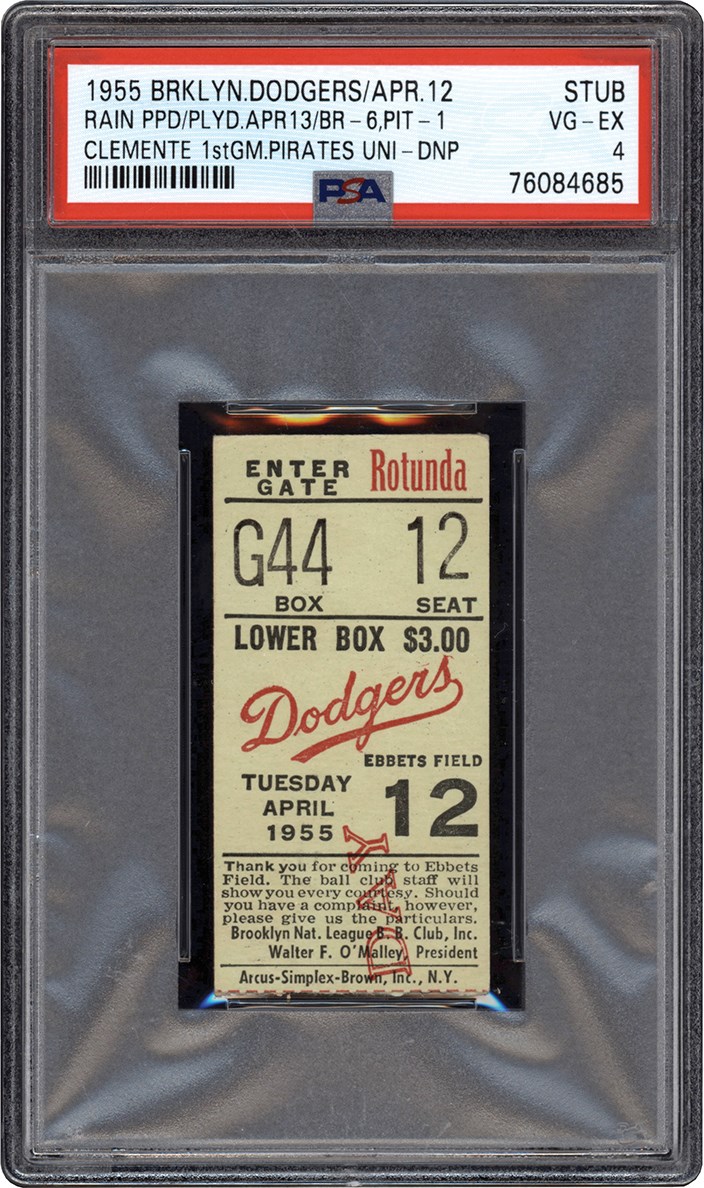
Tickets, Publications & Pins
Lot # 913: 1955 Roberto Clemente First Game in Pirates Uniform Ticket Stub PSA VG-EX 4 (Pop 1 of 1 Highest Graded)Originally scheduled for April 12 but postponed until April 13th due to rain, the Pirates were in Brooklyn to play the Dodgers for the first time of the highly anticipated 1955 season. As one would imagine, the fans at Ebbets field were waiting with bated breath to see their "Bums," Jackie Robinson, Roy Camapanella, Duke Snider and the rest run onto the field. Another part of the field one might have considered looking at that beautiful day in Brooklyn would have been the Pirates dugout. Sitting in the dugout with the rest of the team was a young, fresh faced Roberto Clemente in his Pirates uniform for the first time ever. Although he did not make an appearance on the field that day, Roberto was well on his way to becoming a household name. Born in Puerto Rico, where he played his first professional ball at age 18, he was offered a minor league contract coincidentally by the Brooklyn Dodgers before he was drafted as a 1st round selection by the Pirates in 1954. From that memorable day comes this beautiful ticket stub. Clean with bright red "Dodgers" lettering, this exquisite ticket has been graded and encapsulated VG-EX 4 STUB by PSA. Remarkable piece.
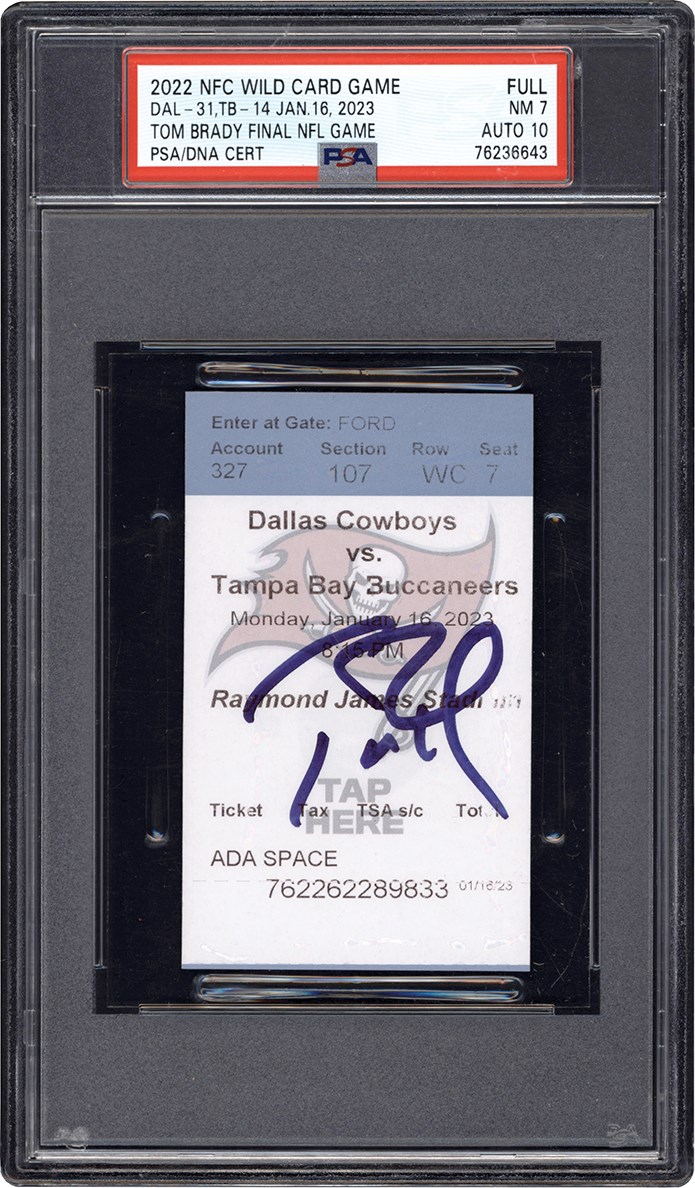
Football
Lot # 1176: 1/16/23 Tom Brady Signed Last Career Game Full Ticket PSA NM 7 Auto 10 (Only Known Example)Tom Brady's last NFL appearance was on January 16, 2023, during the 2022 NFC Wild Card Game at Raymond James Stadium versus the Dallas Cowboys. Brady threw for 351 passing yards and 2 touchdowns in his final appearance on the field, proving he was still capable of feats that nobody has ever been able to do at the astonishing age of 45. One also notices that it easily could have been 400 yards with 3 touchdowns if Mike Evans could have held onto a late fourth quarter pass. Although he had a strong record against the Cowboys up to that point in his career, January 16th wouldn't be Tom's night and Dallas would come out ahead when the last whistle blew. It is fitting however that his last game was in the playoffs; it will seem a little awkward for some of us when the Playoffs come around and Brady is nowhere to be found.
Since Tom Brady first burst onto the scene in 2001, he played in an unimaginable 48 playoff gamesduring his remarkable career and is widely regarded as the best. When it was all said and done, Tom Brady officially retired from his 23-year NFL career on February 1, 2023, ranking first all-time in numerous categories including 251 wins; 10 Super Bowl appearances; 5 Super Bowl MVP awards; 15 Pro Bowls; 7,753 completions; 12,050 attempts; 89,214 passing yards and a miraculous 649 passing touchdowns. From his last game on January 16th comes this remarkable Full ticket. In the new world of electronic tickets and fans getting into events with their smartphone, printed tickets are almost never used or seen. This extremely scarce and sought after example has been signed by Brady in bright blue and has been Dual Graded and encapsulated FULL NM 7 Auto 10 by PSA and is a true Pop 1 example.
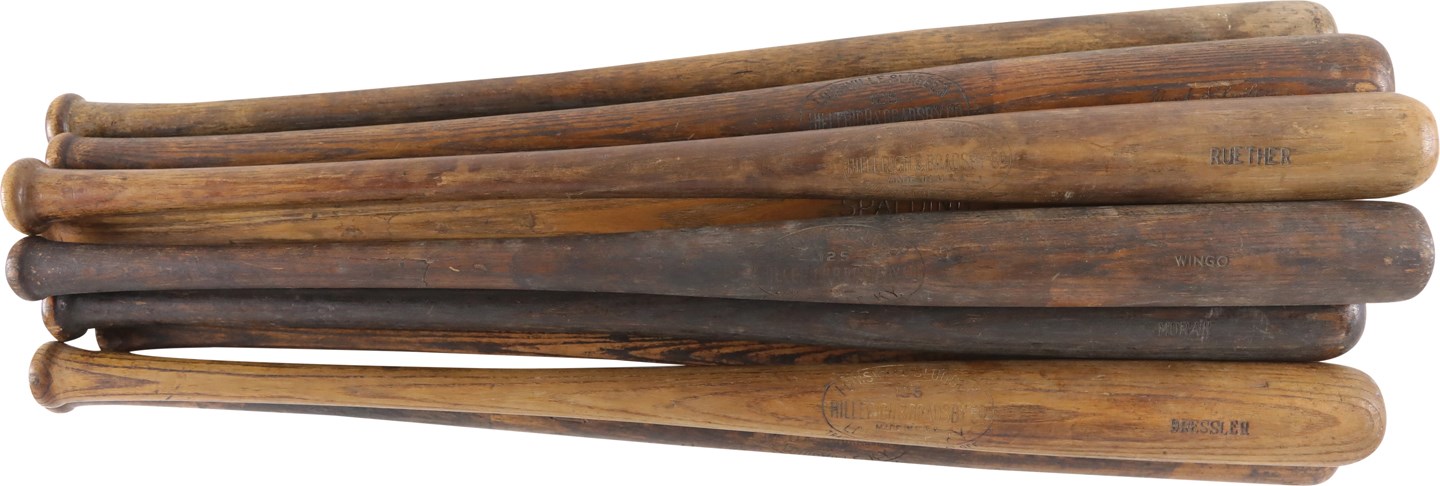
Pete Rose & Cincinnati Reds
Lot # 874: 1919 Cincinnati Reds Game Used Bat Collection (11)Extraordinary collection of eleven pro-model bats, each of which was produced and used by a different member of the 1919 World Champion Cincinnati Reds. This is the most comprehensive 1919 Cincinnati Reds game-used bat collection extant and several of the bats represent the only known examples. It must be noted, that not every bat in the collection dates precisely to the 1919 season, but all were used by the respective player during that approximate time period.
The 1919 Cincinnati Reds are one of the most legendary World Champion clubs because of their opponent: the Chicago White Sox. Despite winning 96 games and finishing nine games ahead of the New York Giants, the Reds 1919 World Series victory has always been tainted due to the actions of Chicago's infamous "Eight Men Out," who conspired to "throw" the Series. Many of the Reds players later bristled at the public sentiment that their World Championship wasn't legitimate, especially the fiery Edd Roush, who vehemently insisted throughout the remainder of his life that the Reds were the better team. While no one will ever know what the outcome would have been under different circumstances, fate has forever immortalized the 1919 Reds in the annals of baseball history.
Unless otherwise noted, all the bats are H&B models dating from the 1922-1930 manufacturing period and display moderate to heavy use throughout. A few of the bats display side writing (duly noted) on the barrel, which indicates that they were returned to the H&B factory to be used as a template for future bat orders. The collection consists of the following bats: 1) Pat Moran. No manufacturer's stampings (year of manufacture unknown). "Moran" stamped in block letters on the barrel. Not cracked. 34" 30 oz. 2) Rube Bressler. "Bressler" stamped on the barrel in block letters. Side writing on the barrel. Heavy checking on the back of the barrel repaired with ten vintage nails. 35" 35 oz. 3) Larry Kopf. 1910-1915 manufacturing period. "Larry Kopf" stamped on the barrel in block letters. Multiple crack in the upper handle and heavy checking on the back of the barrel, each repaired with vintage nails. 35" 32.5 oz. 4) Ivey Wingo. 1916-1922 manufacturing period. "Wingo" stamped on the barrel in block letters. Multiple crack in the handle. Side writing (illegible) on the barrel, along with the outline of a former mailing label. 34.5" 36.25 oz. 5) Dutch Ruether. "Ruether" stamped on the barrel in block letters. Side writing on the barrel (partially legible, including the name "Richards"). Crack in the upper handle. 35" 33.25 oz. 6) Manuel Cueto. Spalding (circa 1918-1925). "Emanuel Cueto" stamped on the barrel in block letters. Repaired crack in the handle. 34.5" 34.125 oz. 7) Hank Schreiber. Signature model, with "Hank Schreiber" facsimile signature stamped on the barrel. The name "Custer" is carved in the barrel, directly to the right of the stamped signature. Side writing (illegible) on the barrel. Crack in the handle. 35" 32.125 oz. 8) Roy Mitchell. "Mitchell" stamped on the barrel in block letters. Side writing (illegible) on the side of the barrel. Crack in the handle repaired with a vintage nail. 35" 36.125 oz. 9) Pat Duncan. 1916-1922 manufacturing period. "Duncan" stamped on the barrel in block letters. Side writing on the barrel (partially illegible, the name "Chas" can be seen) along with remnants of the shipping label. Large multiple crack in the handle repaired with several size vintage nails. 35.5" 34.75 oz. 10) Jimmy Smith. Spalding (circa 1918-1925). "L. Smith" stamped on the barrel in block letters. Side writing (illegible). Crack in the handle and checking on the back of the barrel that has been repaired with numerous small, vintage nails. 33.5" 35.75 oz. 11) Walter Rehg. Signature model. "Walter Rehg" facsimile signature stamped on the barrel. Rehg played in the minor leagues exclusively during the bat's manufacturing period (1922-1930). Crack in the handle and heavy checking on the back of the barrel that has been repaired with numerous vintage nails. 34" 36.25 oz.

Baseball Equipment
Lot # 9: 1948 Johnny Mize New York Giants Game Worn Jersey (Possibly Photo-Matched to 1948 Bowman Card!)Possible Photo-Matches: We have recently discovered two possible photo-matches, including Mize's 1948 Bowman card. Photos have been uploaded.
New York Giants road jersey worn by Hall of Fame slugger Johnny Mize in 1948. Like those of most Hall of Famers who played during the 1930s and 1940s, Johnny Mize game-worn jerseys are scarce. This one of only three we have ever handled and we cannot recall having seen more than three others at auction in the past twenty years. The jersey also has a unique provenance. Our consignor's parents were very close friends with a woman who was very involved with the New York Giants fan club during the late 1940s. She received the jersey directly from Mize and shortly after presented it to our consignor's father, because she knew he was a big fan. It has remained in the possession of our consignor's family since that time and is therefore new to the hobby.
The gray flannel zipper-front jersey is lettered "New York" across the front and features the number "15" on the reverse. All letters and numerals are applied in black-on-orange felt. Located in the collar are a "MacGregor 44" label and a white strip tag featuring the player's name and uniform number ("Mize 15") chain-stitched in red. The year ("48") is chain-stitched in red on a white strip tag located on the interior left front tail. Heavy wear is displayed throughout. The zipper is no longer functional and there is a small hole on the front. A small tear along the edge of the right sleeve also breaks the black-and-orange piping. Despite the minor flaws, the jersey is all original (which is uncommon for garments from this era) and it presents exceptionally well.
Mize enjoyed another banner season in 1948, leading the National League in home runs with 40, while driving in 125 runs and batting .289. One of the top hitters of his era, Mize was one of the few sluggers to also hit for average. In addition to leading the league in home runs on four separate occasions, Mize also batted over .300 in each of his first nine seasons and won the National League batting crown in 1939 with a .349 average. Mize finished his career in 1953 with 359 home runs, 1,337 RBI, and a .312 lifetime average. Those power numbers would be even more impressive if Mize hadn't lost three full seasons to military service from 1942 to 1944. He was elected to the Hall of Fame in 1981.
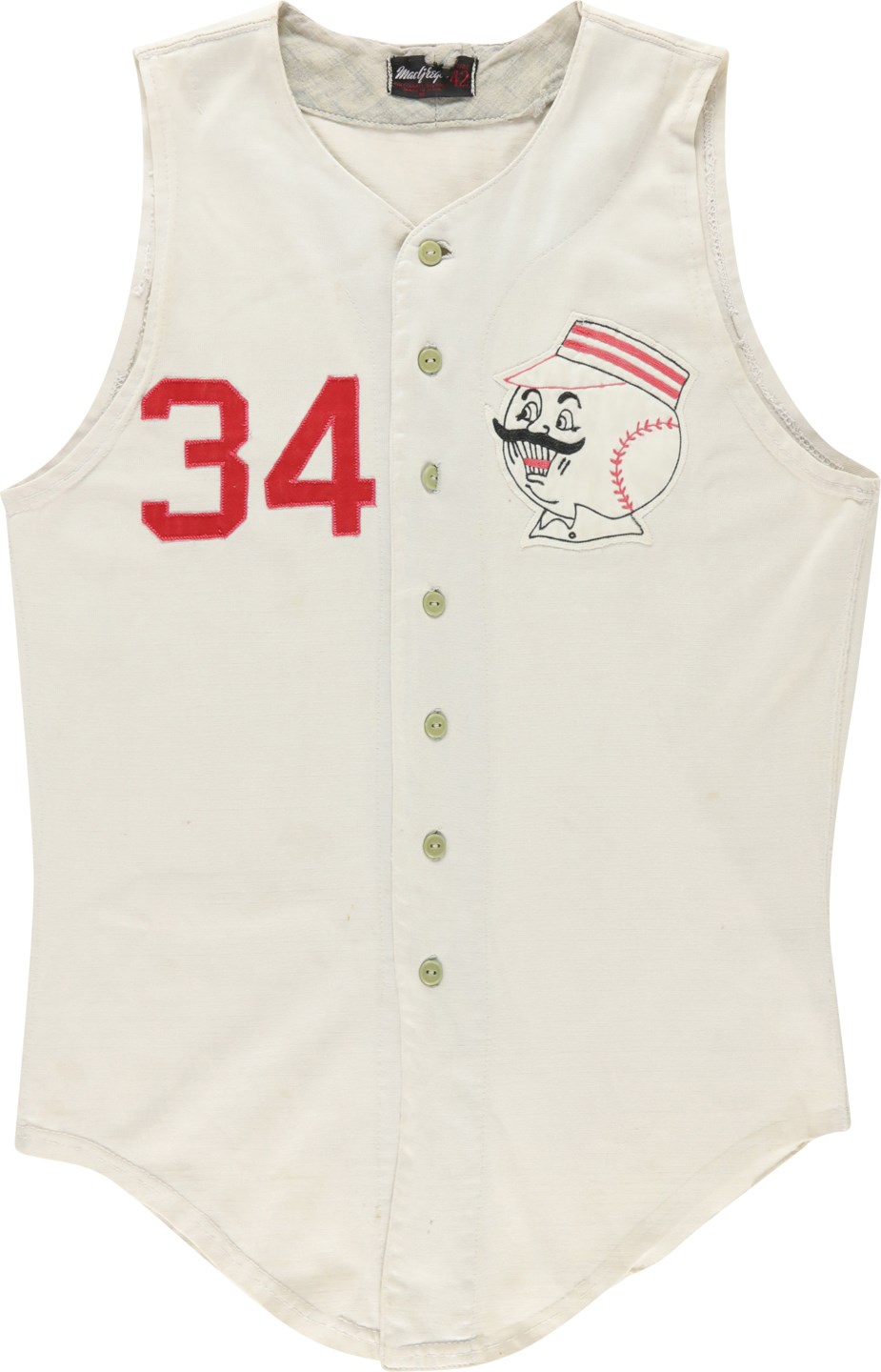
Pete Rose & Cincinnati Reds
Lot # 862: Rare 1956 Russ Meyer Cincinnati Redlegs Game Worn JerseyPresented is a 1956 game worn, all original, Cincinnati Redlegs' jersey of pitcher Russ Meyer, probably the most desirable of all the Redlegs' styles because it was used for such a short period. Since 1890, when Cincinnati transferred from the then Major League American Association - in which the team was named the Cincinnati Red Stockings - Cincinnati's National League franchise has been called the "Reds," with the exception of 1954-58, when the franchise was known as the "Redlegs." The temporary change in nicknames was because during the mid-1950s many Americans were concerned about the United States-Soviet Union "Cold War," and spearheaded by U.S. Senator Joseph McCarthy's investigations, many citizens were concerned about possible Communist influence in America. Since the nickname for Communists is "Reds," the Cincinnati franchise changed the team's name to "Redlegs" for five years, until the fears of Communist or "Red" subversion had diminished. Thus, a Redlegs' jersey, because of its rarity, has increased value to collectors. Meyer was a Major League pitcher for all or parts of 13 seasons: Chicago Cubs (1943-48 & '56), Philadelphia Phillies (1949-52), Brooklyn Dodgers (1953-55), Cincinnati Redlegs (1956), Boston Red Sox (1957), and Kansas City Athletics (1959). A right-hander, Meyer earned the nickname "Mad Monk" from his notoriously short temper. He had a career record of 94-73, with a lifetime ERA of 3.99. His best season was 1949, when he went 17-8 with the Phillies, with a 3.08 ERA. In 1955, he was a member of the Brooklyn Dodgers' only World Championship team. In '56, when this white, home jersey was worn, he was briefly on his third team of that season - the Cincinnati Redlegs. A MacGregor size 42 tag in the collar has a tear at the top but is still fully sewn in. Some loose fabric in the neck area inside does not affect the overall appearance of the jersey. "34" is in red tackle twill on the back and right chest area while the Redlegs' Mustache logo is sewn on the left chest area. A "Set 1 1956" tag is inside the front tail. Some loose fabric is also at the bottom of the jersey. Other than the loose fabric, the jersey is in terrific condition and shows optimal game use. This rare Redlegs jersey provides great vintage appeal.
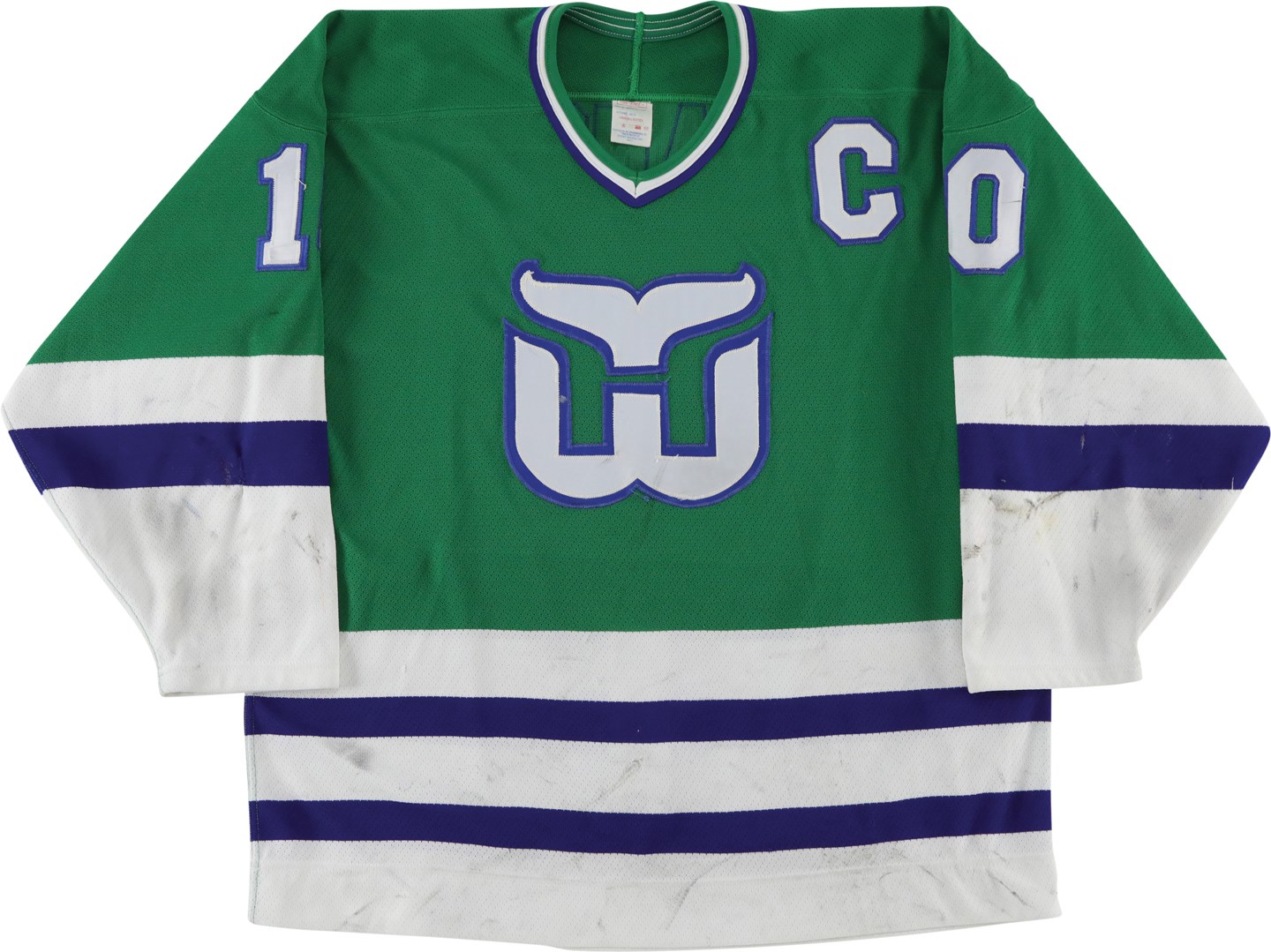
Hockey
Lot # 1186: 1988-89 Ron Francis Hartford Whalers Game Worn Jersey (Resolution Photo-Matched to 1989-90 Topps & O-Pee-Chee Cards)1988-89 Hartford Whalers jersey game worn by popular Hall of Famer Ron Francis. We have handled a few nice Francis Whalers jerseys but we are partial to this one being our favorite as it comes with a Resolution Photo-Matching letter and is definitively matched to five undated images vs. the NJ Devils that are labeled as circa 1989, but the best is the sixth image that it was matched to - his 1989-90 Topps and O-Pee-Chee hockey cards. The green jersey itself is a killer - 100% original with tons of use including stick marks, loose threads, paint transfers, burns, pilling, team repairs, and unrepaired cuts. Maska Air-Knit tag is in the collar, team logo on the chest is formed by two separate pieces, with the "W" and the whale tail forming the Hartford "H" using the green jersey background. Captain's C is on left chest and number 10 is on both sleeves and back, name is on a plate above rear number, all in white-on-blue tackle twill. An 18-year old Francis joined the former WHA franchise in 1981-82, and his pairing with Mario Lemieux after his 1990-91 trade to the Pittsburgh Penguins resulted in a pair of Stanley Cup Championships. In all, Francis recorded 1,798 career points over the course of his 23 NHL seasons, making him an easy selection to the Hockey Hall of Fame. Comes with Resolution Photomatching documentation along with a 7x5" black wood plaque with plate reading, "Ron Francis Game Worn Jersey."
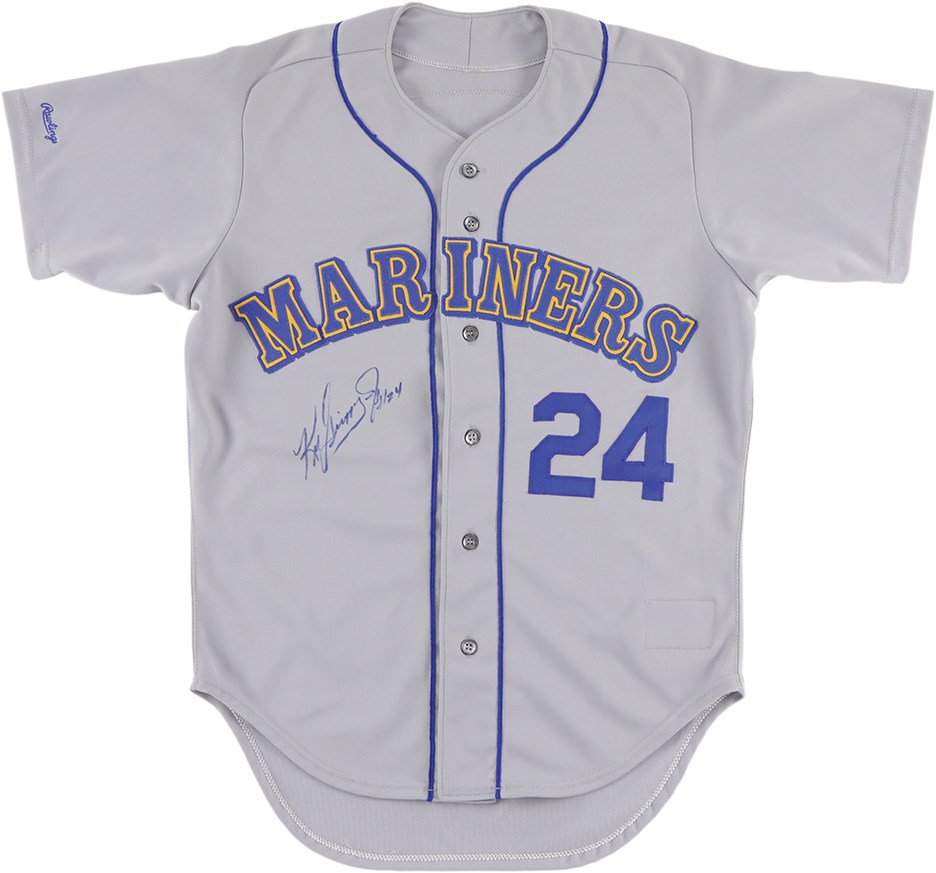
Baseball Equipment
Lot # 664: 1989 Ken Griffey Jr. Seattle Mariners Rookie Signed Game Worn Jersey (MEARS A10 & JSA)As popular and prolific a superstar as Ken Griffey, Jr., was, it comes as no surprise that his memorabilia has generated a surge of interest in the collectibles world. This signed 1989 Seattle Mariners road jersey was worn during the Hall of Famer's rookie year and is tough to beat, earning a perfect A10 grade from MEARS. Gray button-front top has blue piping and MARINERS across the chest in blue-on-yellow-and-blue 3-D style lettering. Rawlings MLB size 44, and Set 1 1989 tagging are sewn inside the tail near the left hip. Number 24 is below left of the name on front as well as on back; name is on a plate above the rear number, all in blue letters and numbers. Signed on the right front below the team name in 9/10 blue Sharpie and inscribed with his number 24. Junior's 630 career home runs total ranks 7th on MLB's all-time list, he earned 13 All-Star Game nods, and his exceptional fielding led to no less than 10 Gold Glove awards. Griffey Jr's 99.32% vote for Hall of Fame induction in 2016 was a record at the time, surpassed only by Mariano Rivera (100%, 2019), and Derek Jeter (99.74%, 2020), leaving him truly in a class among the game's all time elites. Comes with MEARS letter grading this jersey A10, plus JSA LOA for the autograph.

Baseball Equipment
Lot # 709: 1989 Ken Griffey Jr. Rookie Seattle Mariners Signed Game Used Bat with Rookie Signature (PSA GU 9.5)A holy grail piece for any late 1980s baseball fan of a certain age, this 1989 Ken Griffey Jr. game used and signed bat comes from the fan favorite and Hall of Famer's rookie season in Seattle with the Mariners. Cooper model C271 sources from the 1989 labeling period, measures in at 34", weighs 31.6 ounces and features the standard finish. Fine rookie example shows fine use with light pine tar, blue bat rack streaks, "34 - 31oz" stamp on the knob, a cracked handle and criss-cross tape job seen on many of his bats during his rookie season. Griffey Jr. hit 16 home runs during his rookie campaign and was well on his way to becoming the superstar he is remembered as today. If injuries hadn't plagued his late-career production, who knows what Ken Griffey Jr.'s final statistics could have looked like? The bat was signed and inscribed "24" by the future Hall of Famer and 600 Home Run Club member circa 1989 in bold black Sharpie. Comes with a PSA GU 9.5 LOA for use and PSA hologram for signature.
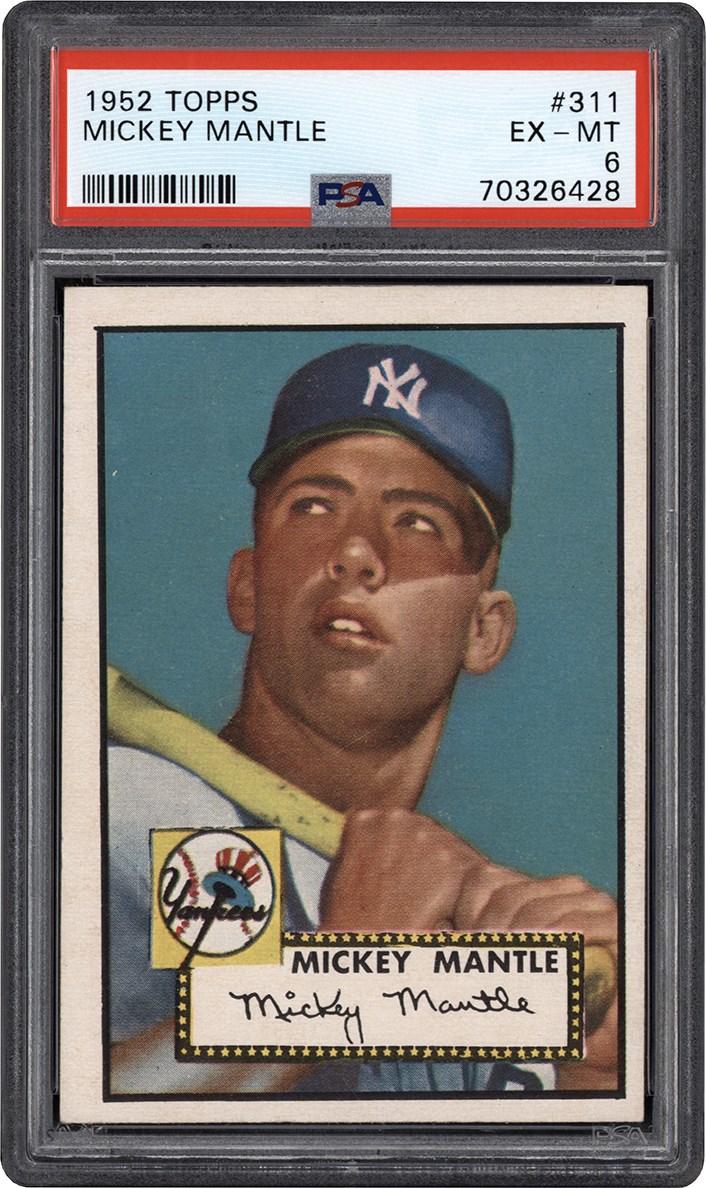
Baseball and Trading Cards
Lot # 2: 1952 Topps Baseball #311 Mickey Mantle PSA EX-MT 6 - Newly Discovered Example1952 Topps Baseball #311 Mickey Mantle First Topps card. Graded EX-MT 6 by PSA. This is an outstanding example of the hobby's most iconic postwar baseball card. It should be noted that of the 1,813 examples of this card listed in the PSA Population Report, only 121 have received a higher grade. A total of 122 have been graded at this level, meaning that this card ranks in the top 8% of all PSA-graded 1952 Topps Mickey Mantle cards. The card retains white borders and the edges appear smooth. Three of the corners are sharp while the bottom left has a slight touch. Centering is off both top to bottom and left to right. The reverse is clean and bright.
This card originates from a new find of 1952 Topps baseball cards that recently surfaced in the Midwest. Highlights included two examples each for Mantle, Mays, and Robinson, as well as many high numbers. Our consignor's husband collected the cards as a child and, miraculously, nearly all avoided the common fate of being repeatedly flipped or placed in bike spokes. Instead, he carefully stored them in a shoe box, where they remained, untouched, for the past seventy years. The majority of the cards are in mid-to-high grade, with the only issue of note for most being centering. Three of the cards (Mantle, Mays, and Robinson) made their hobby debut in our Winter Focus Auction. The balance of the collection is offered here in this sale. All the graded cards in this collection were submitted by Lelands.
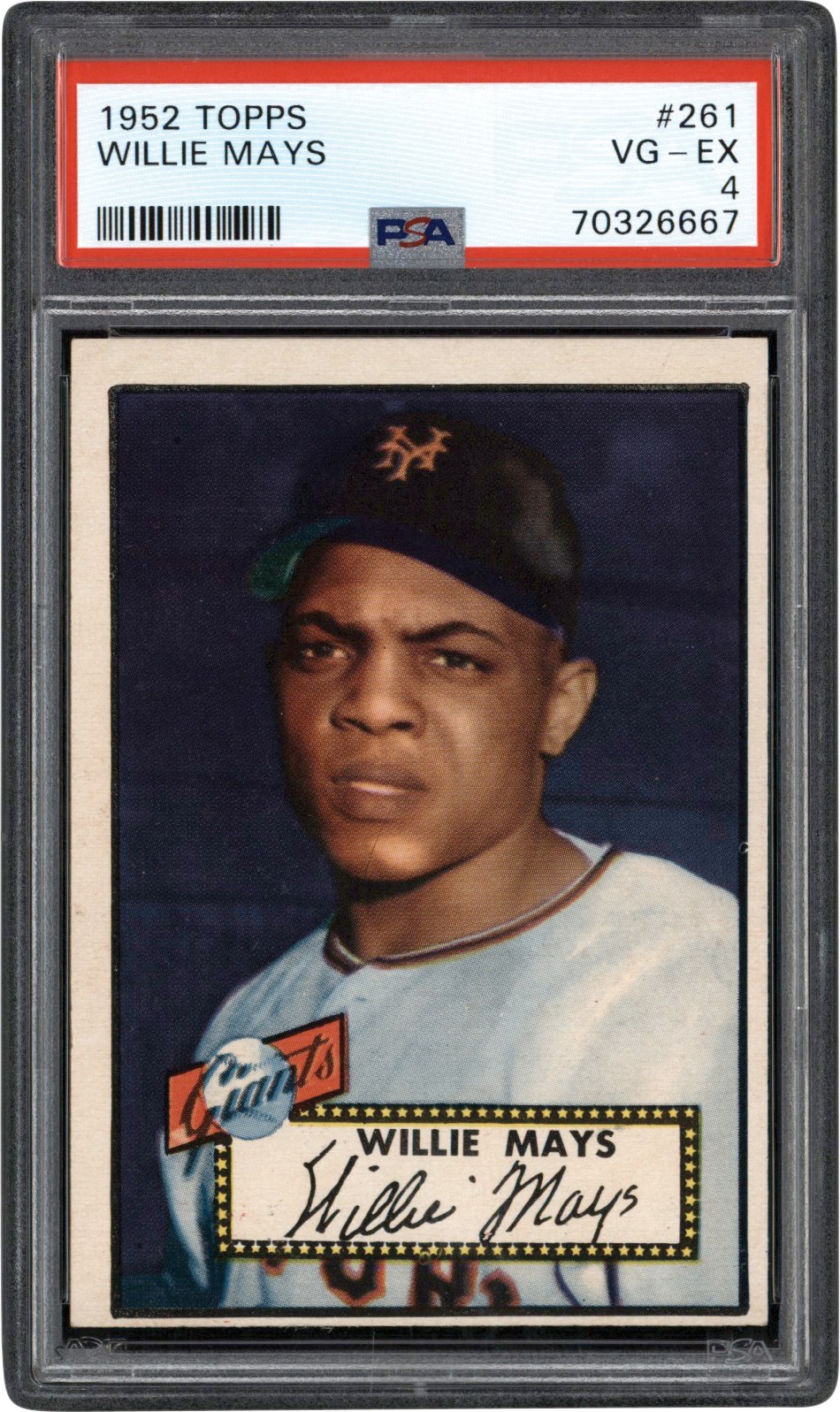
Baseball and Trading Cards
Lot # 159: 1952 Topps #261 Willie Mays PSA VG-EX 4 - Newly Discovered Example1952 Topps Baseball #261 Willie Mays. This card originates from a new find of 1952 Topps baseball cards that recently surfaced in the Midwest. Highlights included two examples each for Mantle, Mays, and Robinson, as well as many high numbers. Our consignor's husband collected the cards as a child and, miraculously, nearly all avoided the common fate of being repeatedly flipped or placed in bike spokes. Instead, he carefully stored them in a shoe box, where they remained, untouched, for the past seventy years. The majority of the cards are in mid-to-high grade, with the only issue of note for most being centering. Three of the cards (Mantle, Mays, and Robinson) made their hobby debut in our Winter Focus Auction. The balance of the collection, including an EX-MT 6 Mantle, is offered here in this sale. All the graded cards in this collection were submitted by Lelands. The card has been graded and encapsulated by PSA VG-EX 4. It retains deep and rich coloring on the image of a scowling Mays against a dark background. The borders are white and the edges are smooth. The corners have light touches. Centering is off left to right as well as top to bottom. The reverse is clean but severely off center.
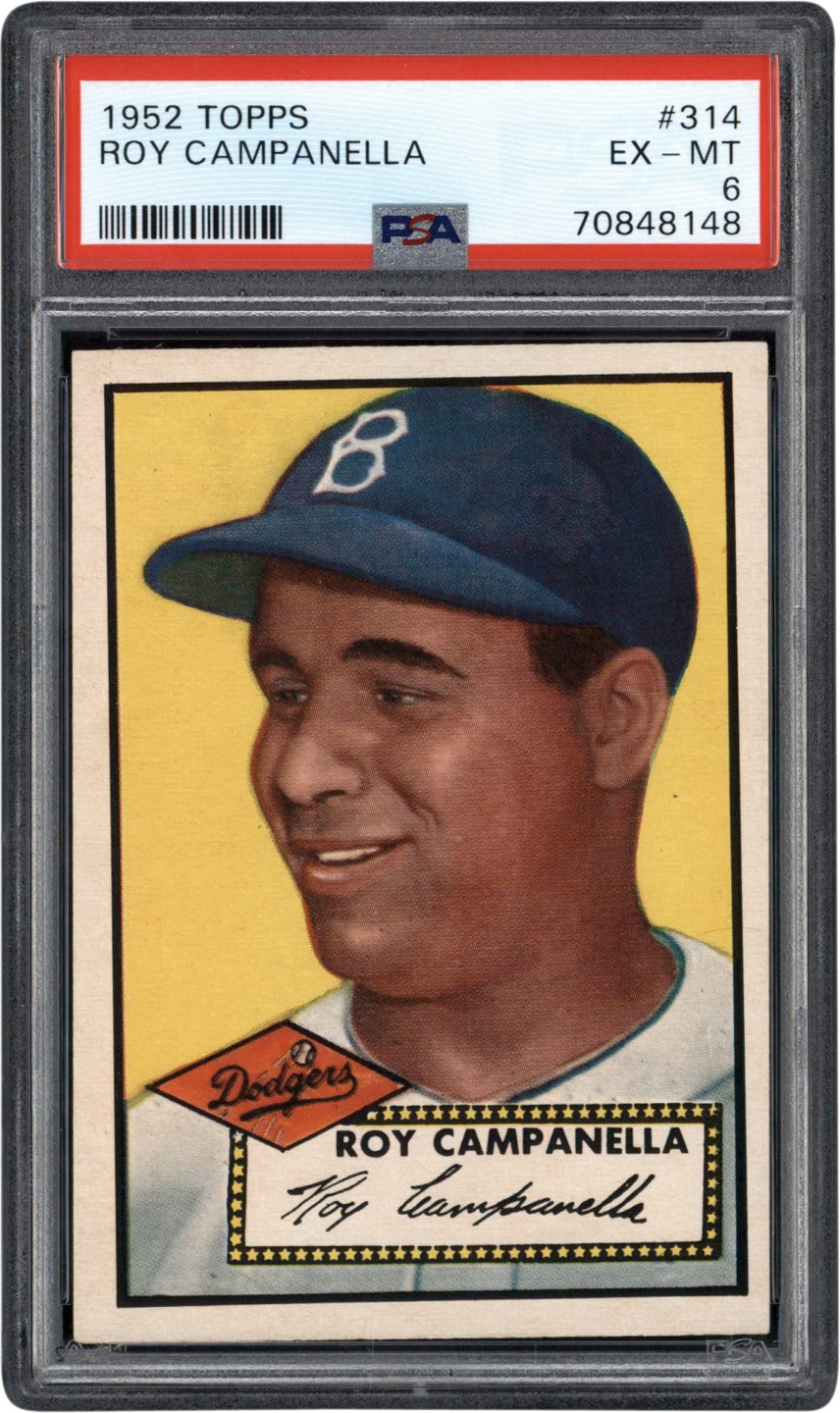
Baseball and Trading Cards
Lot # 163: 1952 Topps #314 Roy Campanella PSA EX-MT 6 - Newly Discovered Example1952 Topps Baseball #314 Roy Campanella. This card originates from a new find of 1952 Topps baseball cards that recently surfaced in the Midwest. Highlights included two examples each for Mantle, Mays, and Robinson, as well as many high numbers. Our consignor's husband collected the cards as a child and, miraculously, nearly all avoided the common fate of being repeatedly flipped or placed in bike spokes. Instead, he carefully stored them in a shoe box, where they remained, untouched, for the past seventy years. The majority of the cards are in mid-to-high grade, with the only issue of note for most being centering. Three of the cards (Mantle, Mays, and Robinson) made their hobby debut in our Winter Focus Auction. The balance of the collection, including an EX-MT 6 Mantle, is offered here in this sale. All the graded cards in this collection were submitted by Lelands. The card has been graded and encapsulated by PSA EX-MT 6. It has a colorful image of a smiling Campanella against a bright yellow background. The borders are white while the edges appear smooth. All four corners have light touches. Centering is off left to right. The reverse is clean.

Baseball and Trading Cards
Lot # 165: 1952 Topps #392 Hoyt Wilhelm PSA NM 7 - Newly Discovered Example1952 Topps Baseball #392 Hoyt Wilhelm. This card originates from a new find of 1952 Topps baseball cards that recently surfaced in the Midwest. Highlights included two examples each for Mantle, Mays, and Robinson, as well as many high numbers. Our consignor's husband collected the cards as a child and, miraculously, nearly all avoided the common fate of being repeatedly flipped or placed in bike spokes. Instead, he carefully stored them in a shoe box, where they remained, untouched, for the past seventy years. The majority of the cards are in mid-to-high grade, with the only issue of note for most being centering. Three of the cards (Mantle, Mays, and Robinson) made their hobby debut in our Winter Focus Auction. The balance of the collection, including an EX-MT 6 Mantle, is offered here in this sale. All the graded cards in this collection were submitted by Lelands. The card has been graded and encapsulated by PSA NM 7. It has a clear and colorful image of a smiling Wilhelm against a light blue background. The borders remain white and the edges are smooth. All four corners are sharp. Centering is slightly off top to bottom. The reverse is clear.
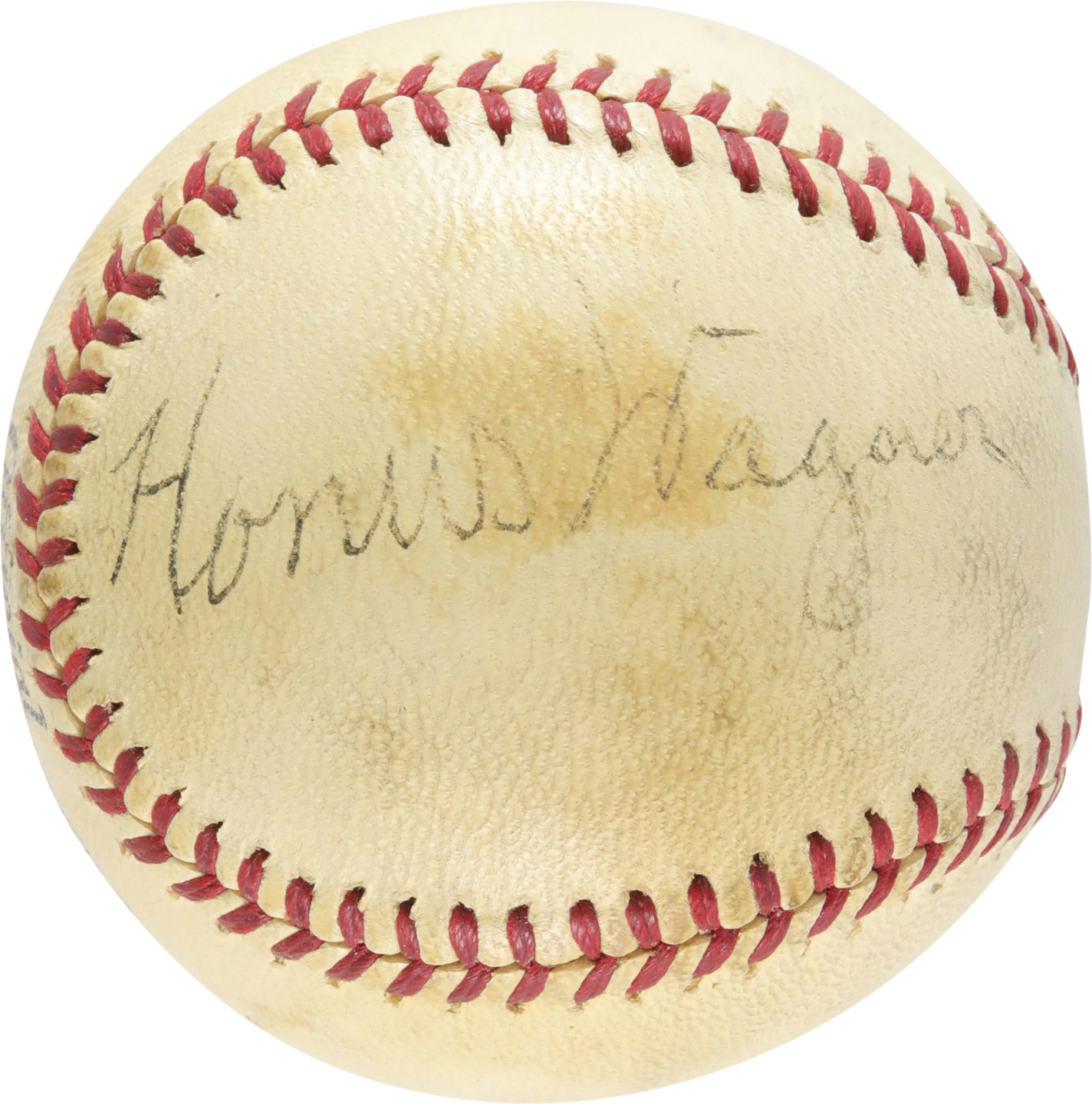
Baseball Autographs
Lot # 514: Honus Wagner Single-Signed Baseball (PSA)Official National League (Frick) ball signed by Hall of Fame shortstop Honus Wagner. The legendary "Flying Dutchman" has scripted his name in black fountain pen on a side panel, with the signature grading 6/10 overall. This ball dates from the 1941-1942 manufacturing period, a time when Wagner was a coach with the Pittsburgh Pirates. Unfortunately, the ball is connected to a sad story. Our consignor's uncle, a Michigan native, who was the captain of his college football team and a star baseball player, tragically broke his neck while diving at a local swimming hole in 1940. The injury left him paralyzed from the chest down. When news of the accident spread, there was a tremendous outpouring of local support. Among the numerous gifts he received at the time was this ball from Honus Wagner, which has remained in the family until now. The ball displays scattered areas of moderate toning and is otherwise in Excellent to Mint condition. Full LOA from PSA.

Baseball Autographs
Lot # 526: Spectacular Thurman Munson Single-Signed Baseball (PSA NM-MT 8.5 Overall)Not long after the spectacular 1977 World Series where Thurman Munson and the Yankees defeated the Dodgers to win the franchise's 21st World Series championship, their first since 1962, Thurman Munson was asked to help promote the Grand Opening of "The Amherst Sport Spot" sporting goods store on Amherst Road in Massillon, OH. On November 19, 1977 from 11:00 to 1:00pm, Thurman Munson was in the store, meeting enthusiasts and signing baseballs for any customer who purchased anything for $10 or more. Our consignor, the ball's original owner, was in the store that very day, spent $10 and went home with undoubtedly the finest single-signed Thurman Munson ball we've ever encountered. Stored away since that November day in 1977, this Official American League (MacPhail) Spalding baseball was signed on the sweet spot by New York Yankee great Thurman Munson on November 19, 1977, in bright blue ink. Ball presents NRMT+, is white as snow and features blue factory stamps that look as new as can be. It truly looks as if its been in a box, squirreled away since 1977. Comes with copy of original advertisement offering a signed baseball with any purchase at the store, PSA LOA and JSA LOA.
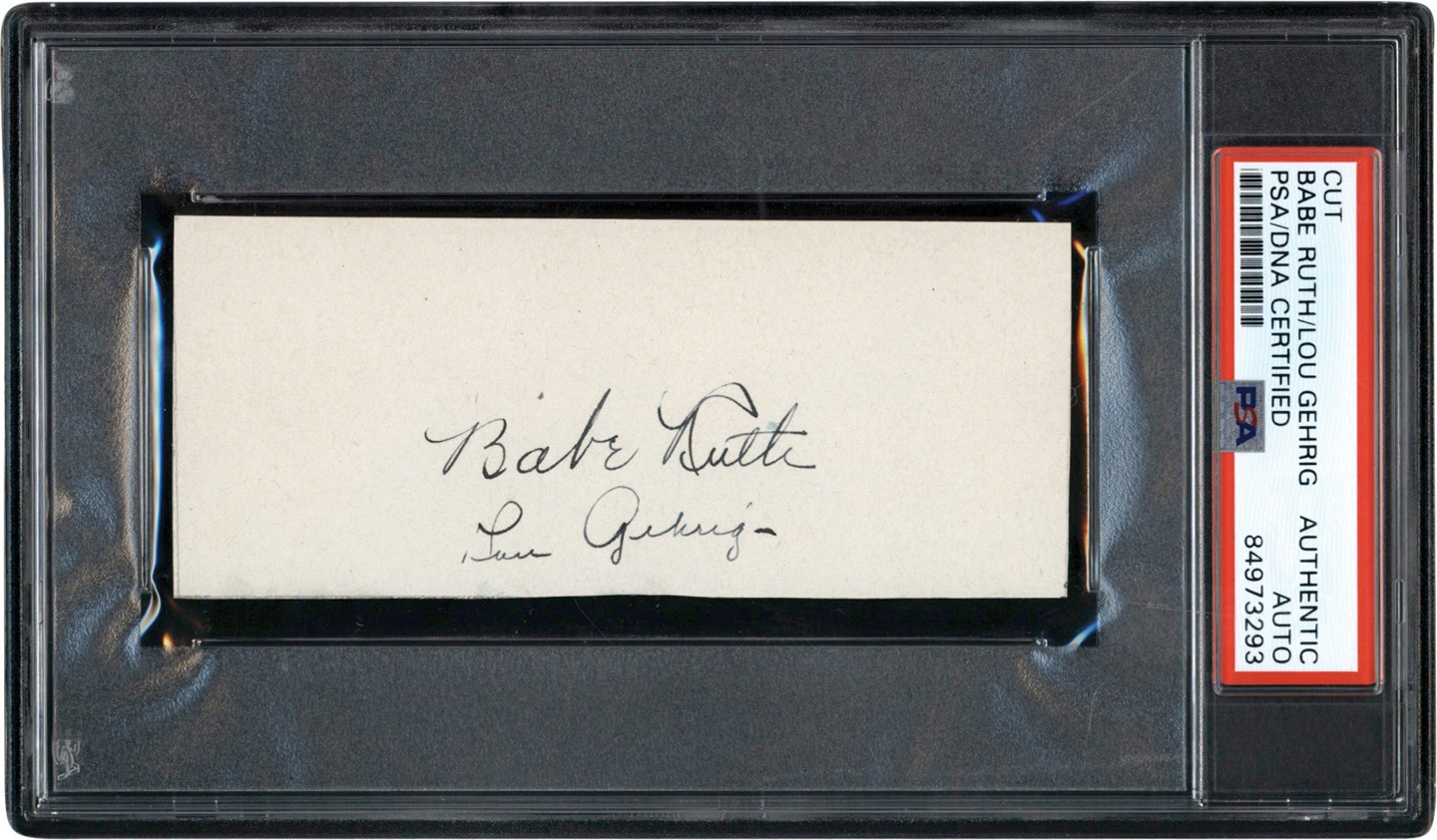
Ruth and Gehrig
Lot # 749: One of the Finest Known Babe Ruth & Lou Gehrig Dual Autographs (PSA)Superb cut dual-signed by New York Yankees icons Babe Ruth and Lou Gehrig. Signatures are on a 4.5x2" cut unlined card stock, both signed in black fountain ink. The Bambino is just below the middle of the card with the Iron Horse squeezed in just below, with both in the solid 8/10 range. Amazing to find both Pinstripes legends on such a clean background and in such close proximity. Encapsulated by PSA/DNA as Authentic Auto for both signatures.

Ruth and Gehrig
Lot # 757: 1948 Babe Ruth Signed Letter to Famed Producer Promoting "The Babe Ruth Story" (JSA)Dated April 12, 1948, and typed on bright white "Babe Ruth - New York" letterhead, this remarkable letter was originally penned and sent to the stage, radio, film, television personality, and Broadway producer Richard Kollmar to help promote his book "The Babe Ruth Story." The short and sweet letter reads, "Dear Richard: I am sending you a copy of my own book THE BABE RUTH STORY which Bob Considine helped me put down on paper. My publishers tell me it will be published on April 26, 1948. I hope you will like it." Written a mere four months before Babe Ruth's passing, the letter is simply signed "Babe." Letter was once tri-folded and has been handsomely framed to 11x14" overall and comes with a copy of, "The Babe Ruth Story" (probably not the copy Ruth sent to Kollmar) and a JSA LOA for the signature.
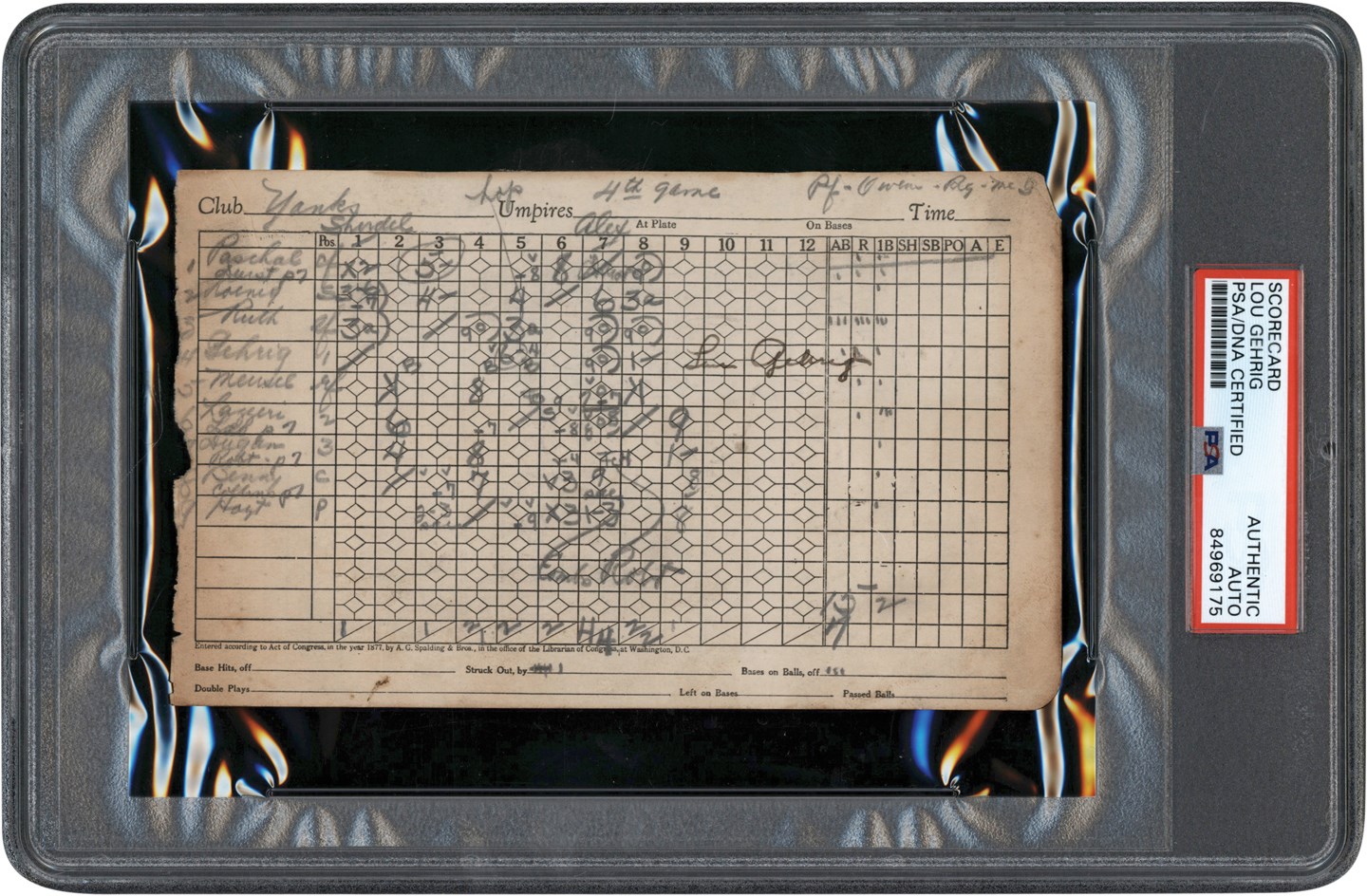
Ruth and Gehrig
Lot # 750: Lou Gehrig Signed 1928 World Series Clinching Game 4 Scorecard - Ruth Hits Three Home Runs! (PSA & JSA)Displayed is a Lou Gehrig signed scorebook page from Game 4 of the Oct. 9, 1928, World Series clinching game in a four-game sweep by the New York Yankees over the St. Louis Cardinals. This clinching game was a 7-3 victory by the Yankees, with Waite Hoyt besting Bill Sherdel. Written on the scorebook page after Sherdel's name is "Alex," apparently a reference to Hall of Fame pitcher Grover Cleveland Alexander, who pitched in relief for the Cards. In the Series' clincher, Hall of Famer Babe Ruth homered THREE times for the Yankees with his first being a bases empty slam in the top of Inning 4. Second HR came in the top of inning 7, and the next hitter, Hall of Fame first baseman Lou Gehrig, followed with another home run, both homers off Bill Sherdel. Ruth hit his third bases-empty home run in the top of Inning 8, off Alexander. Gehrig had a tremendous '28 season, hitting 47 home runs, knocking in 147 runs, and batting .374. Ruth also had a banner '28 season: The Bambino led the American League both in 54 home runs (54), and runs scored (163), and batted .323. The scorebook page measures 4x6.5", and one side of the page is scored for the Yankees and the other side of the page is blank, except for the handwritten "1929," apparently indicating that the scorebook would resume at that page in the upcoming '29 season. In the '28 season, Gehrig was only 25 years old and building his consecutive games streak that would eventually reach a then-record setting 2,130 games in his final season, 1939, when the effects of ALS forced him to withdraw from the lineup and soon retire. Gehrig has signed the scorecard in pen on the right side, just after his name and his batting results listed on the scorecard - on the fourth line. The scorecard page has a few very small tears, areas of darkening and foxing, and a tiny stain. The signed Lou Gehrig scorecard page has been encapsulated and PSA/DNA certified as "AUTHENTIC AUTO." Also comes with JSA LOA.

Jackie Robinson & Brooklyn Dodgers
Lot # 813: 1954 Pair of Extraordinary Jackie Robinson Handwritten Letters to Obsessed Female Fan - "You Must Realize How This Whole Thing Could Look if Something Had Happened and I was in Possession of Your Property" - Four Robinson Signatures in Total (PSA)In 1954 Jackie Robinson found himself involved in an awkward situation with a teenage girl named Miss Duke Agen that, as he was smart enough to realize, could have caused him considerable trouble had the circumstances been different. Luckily, he was proactive in the matter and contacted the young girl's parents before things went any further. These two handwritten letters, written six weeks apart, provide insight into the affair. PSA has individually encapsulated each letter and graded each signature MINT 9.
Both letters are written in blue ink on Hotel Schroeder (Milwaukee, Wisconsin) letterhead, which is where the Dodgers were staying while on the road against the Braves, and are accompanied by their original mailing envelopes. The first is a standard letter of thanks to a fan who expressed interest in Robinson and the Dodgers. Robinson not only signed the letter, but added "Best Wishes Jackie Robinson" at the base of the page, with both signatures graded MINT 9 by PSA. The letter is not dated, but the original mailing envelope is postmarked June 3, 1954.
The second letter to Miss Agen, which was written six weeks later, shows that her actions had gone beyond that of a normal fan. Apparently, she had left home to follow the Dodgers for a short period and then sent her ring to Robinson, who became alarmed at its meaning and contacted her parents. In his letter, Robinson conveys that he was sincerely concerned about her, but admonishes her for her actions. In part: "Please tell your folks for me that my concern was simply because you had sent the ring and I have never seen or talked with you. You must realize how this whole thing could look if something had happened and I was in possession of your property. . . . I have had so much work with teenagers and young adults that I have seen things happen. I just hope you take this letter in the spirit in which it was written." Signed "Jackie Robinson" (graded MINT 9 by PSA)
Like the first, the letter is undated, but is accompanied by the original mailing envelope postmarked July 17, 1954. On this envelope, Robinson has written "J. Robinson/Dodgers" (7/10) above the hotel's return address. Both letters (6x9.5") display horizontal folds, with the first also having a few tiny areas of light discoloration. Each mailing envelope (approximately 6.25x3.75") is in Good condition.
